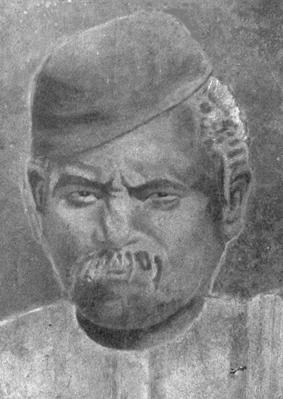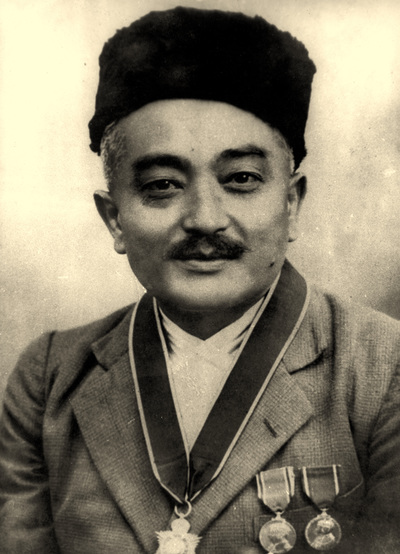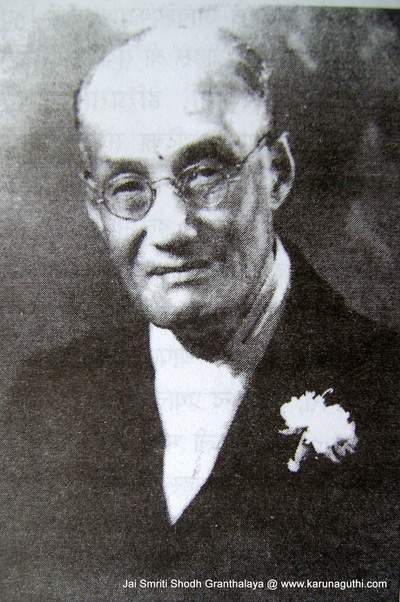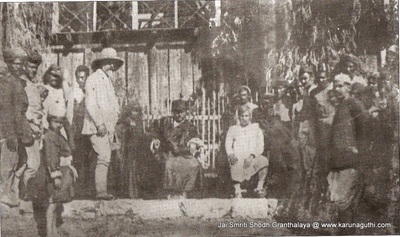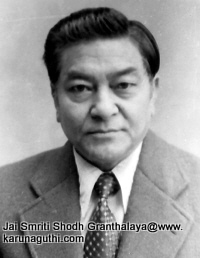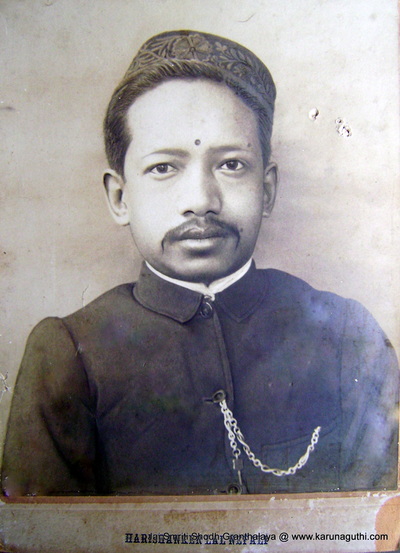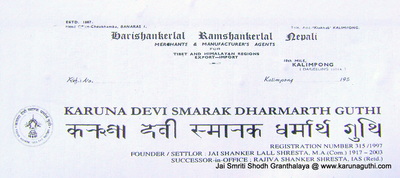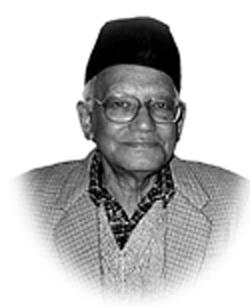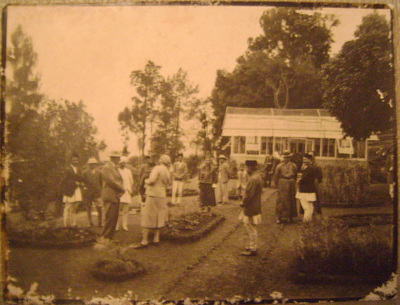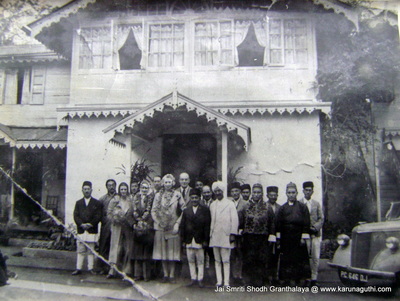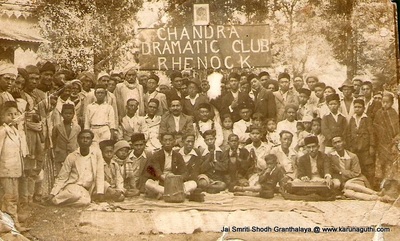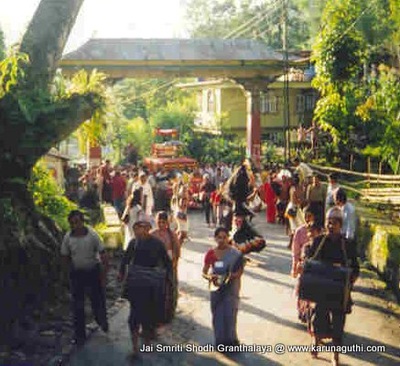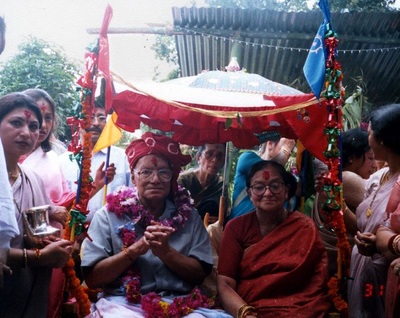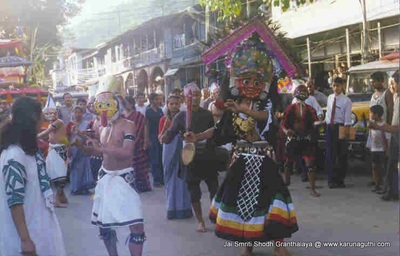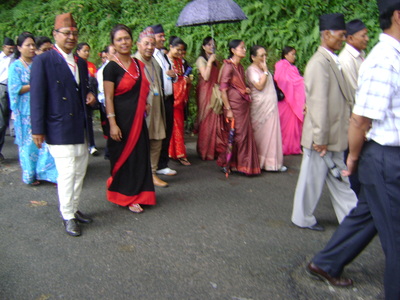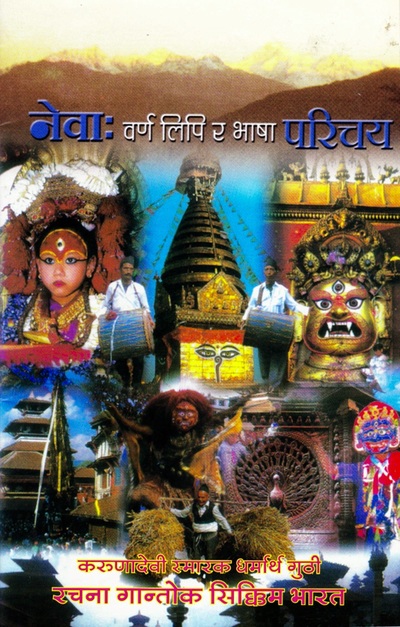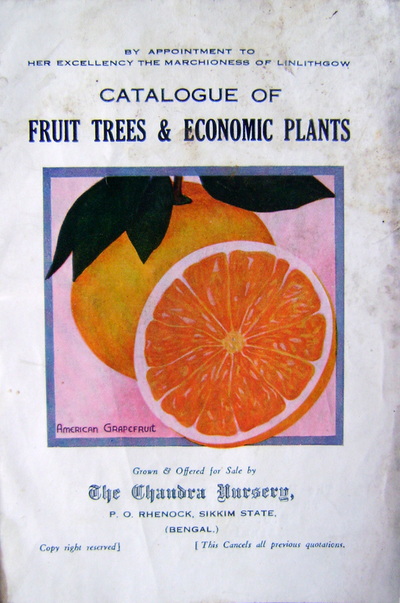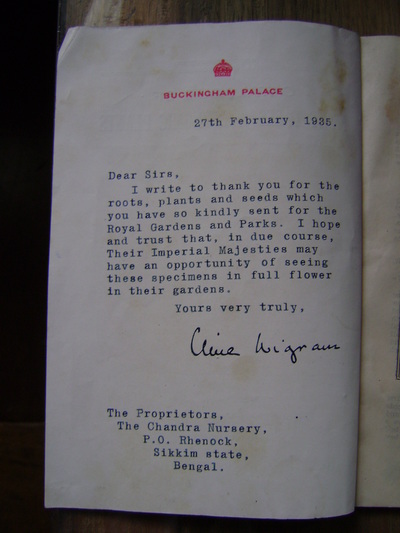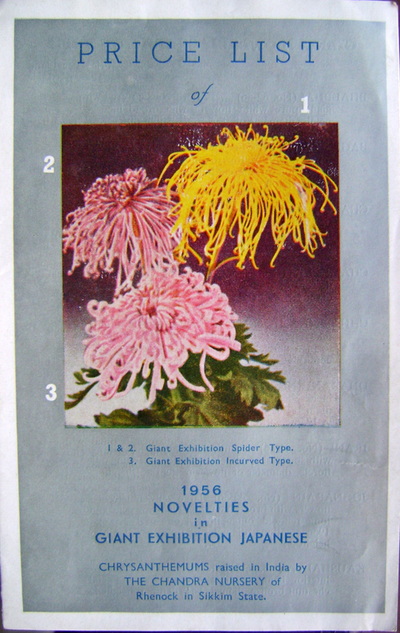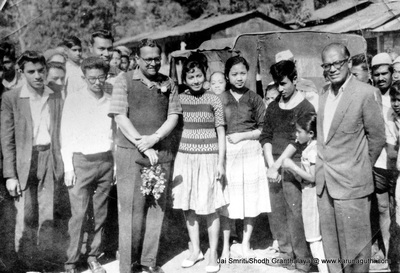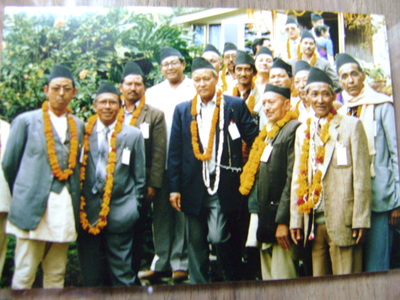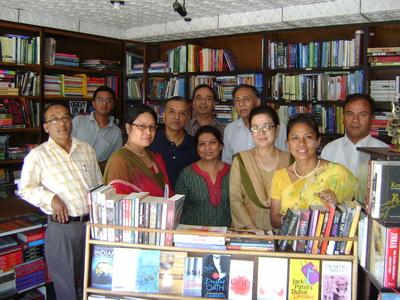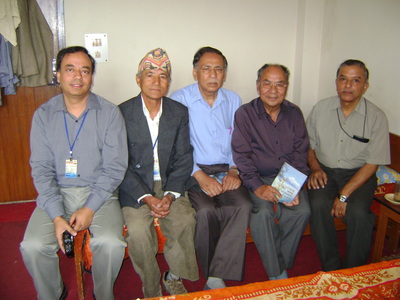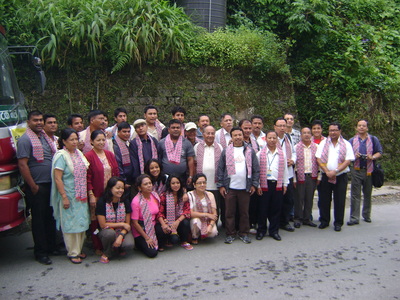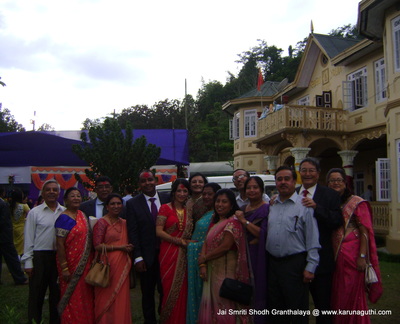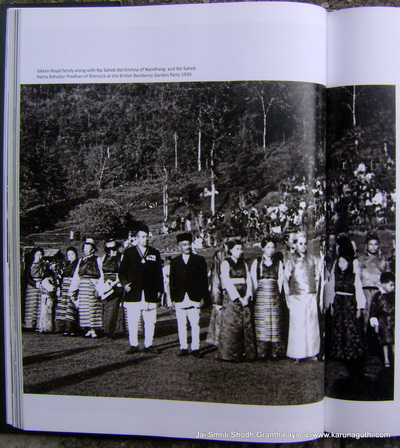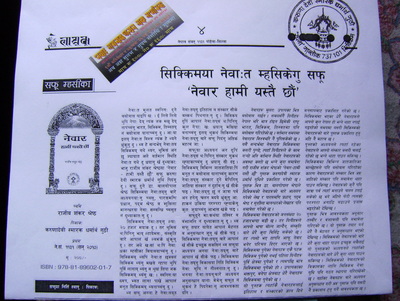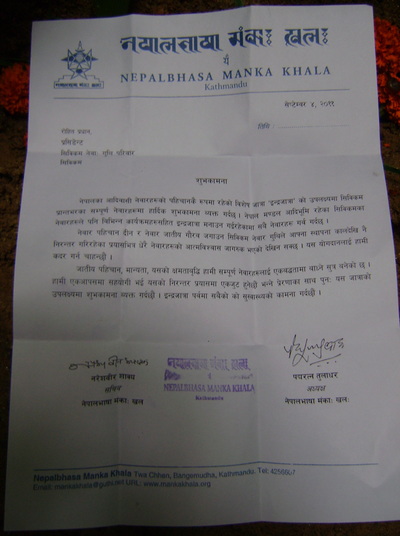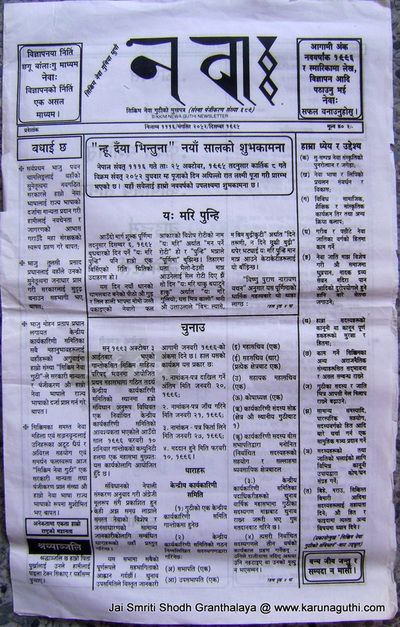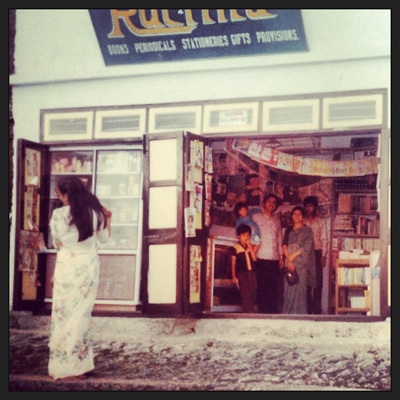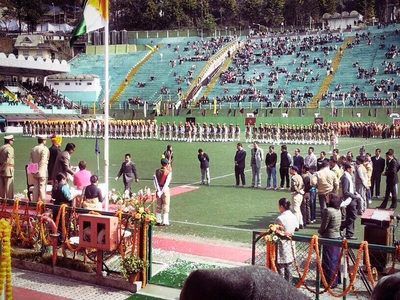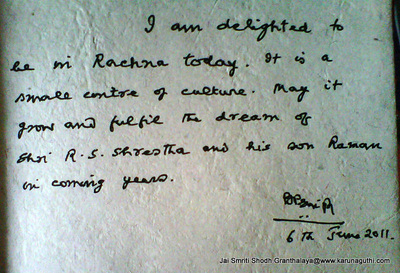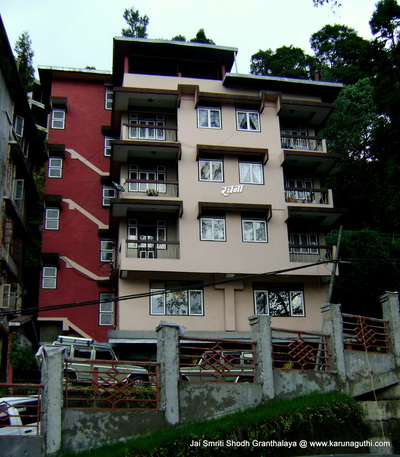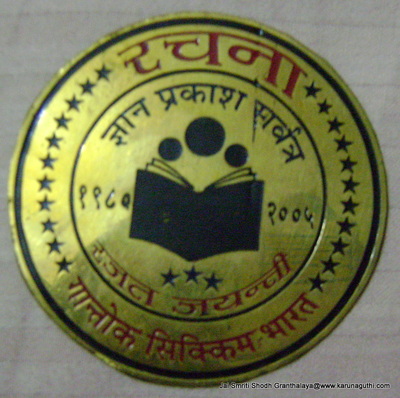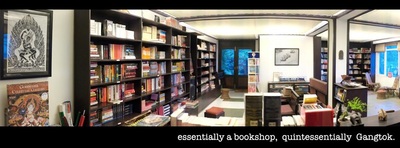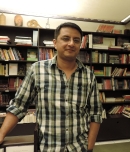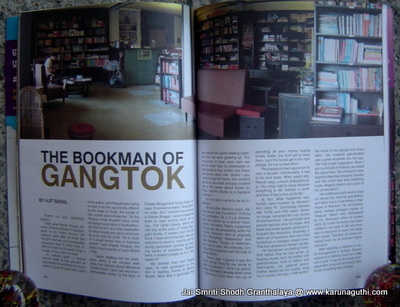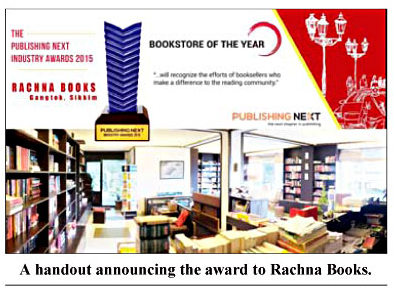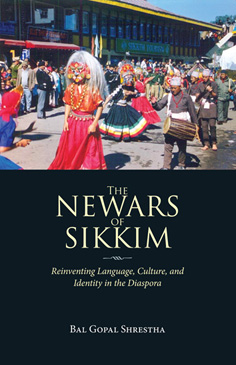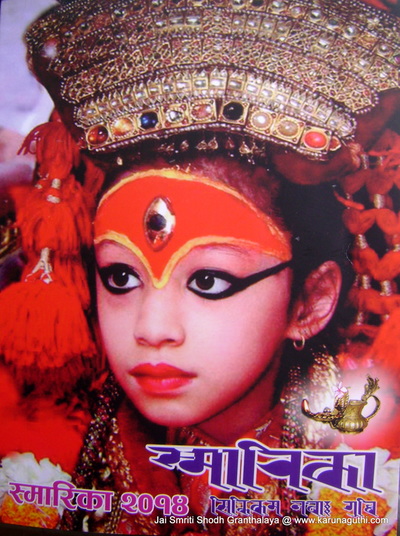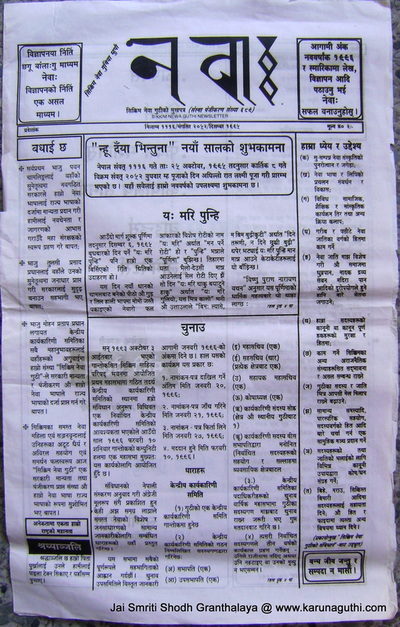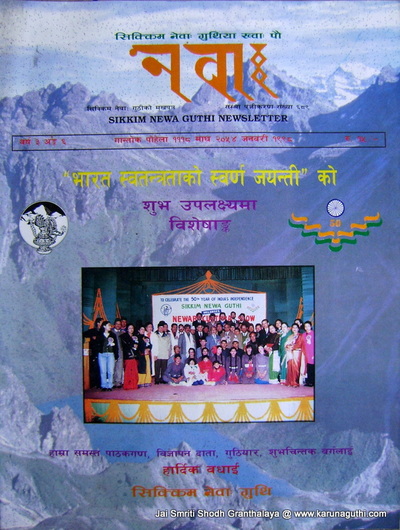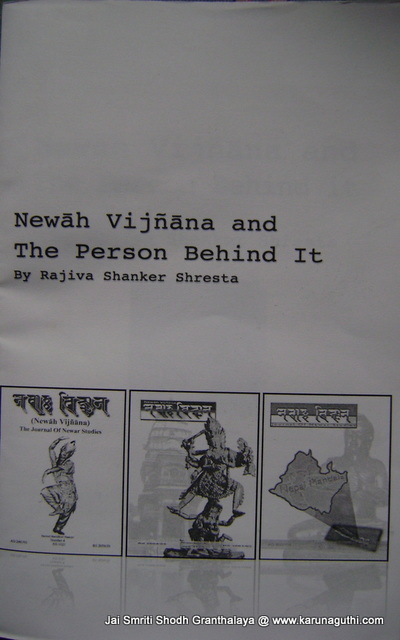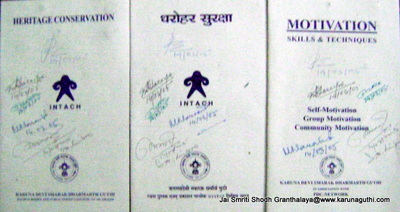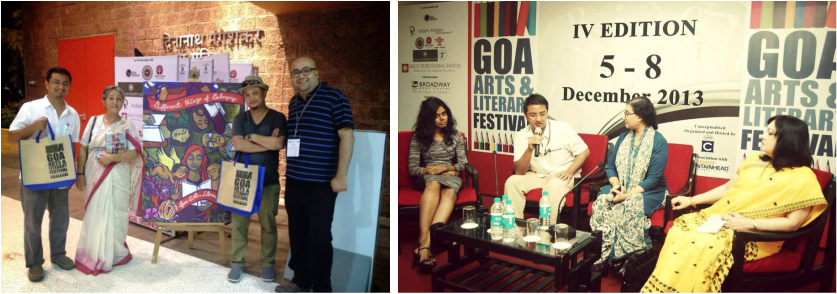
The Newars in Sikkim
Historical, Cultural, Social and Literary Activities
A Brief Introduction
Presented by Rajiva Shanker Shresta for the Karuna Devi Smarak Dharmarth Guthi as
Special Guest Speaker on the occasion of the Nepal Sambat 1136 Bhintuna Celebrations by the
Newah Organisation of America held on Sunday 6th December 2015 at Potomac, Maryland, USA
Jwajalappa/Namaskar! Nhu Dan-ya Bhintuna!!
Respected Chief Guest of this august gathering, honourable Special Guest , honourable President of the Newah Organisation of America, its dedicated executive and other members, distinguished guests, ladies and gentlemen,
On the auspicious occasion of the Nepal Sambat 1136 Bhintuna Celebrations and in commemoration of its founder Shankhadhar Sakhwa I extend my warm Himalayan greetings having myself come from the remote Himalayan state of Sikkim in India. It is a rare privilege for me to be before you addressing on this auspicious day but regret my inability to speak in Nepal Bhasha and seek your kind permission to make this presentation in Nepali on the topic assigned to me The Newars in Sikkim: Historical, Cultural, Social and Literary Activities – A Brief Introduction. Before I proceed further, I offer my warm tributes in fond memory of my late mother and our forefathers as well as to those NOA members who have passed away in the past.
On the outset I would like to offer my heartfelt thanks to the NOA for giving me this rare opportunity to celebrate the New Year Nhu Dan Nepal Sambat 1136 with fellow Newars in America. It is heartening to know that Nepal Sambat is the only claenda year named after a particular country the world over and I pay hearty tributes to its founder. Though we are attached with our neighbouring country Nepal, which has been the source of our social, cultural and literary knowledge but it is awkward for me to mention that many of the Newars in Sikkim somehow do not know the Nepal Sambat and have understood about its importance. With what pomp and grandeur it is seen being observed elsewhere, there is nothing such to be seen in Sikkim and this might be the unique identity for which Sikkim is known to be different. I feel proud with a sense of great satisfaction and happiness participating thus here. This, in fact my third encounter with the NOA, the first was in May 2010 when my book Newar Haami Yastai Chhaun was launched here! I have been greatly impressed by the people love their motherland and community and I have been telling writing that we should all imbibe and replicate the way you have been doing here in the US all these years ceaselessly. I well understand like me you all in the audience here today are also keen on seeing our popular talented artistes perform in the cultural extravaganza to follow. I would, however, like to express my gratefulness and thanks for having been given this rare opportunity to share the international forum.
Historical Background
The advent of the Newars in Sikkim can be traced back to their Darjeeling days established well fleeing from the Kathmandu valley Laxmidas and his brother Chandrabir Newar came here invited a century and a half ago. Taksari Chandravir cleared thick forests full of wild denizens, making roads and bridges for settling down humanity in a difficult place then called Black Hill later to be known as Rhenock that gave Sikkim its first chief secretary from the Nepalese community. He had to face wild protest and scuffles leading to battle. According to Dr. Paras Mani Pradhan, Bhutias declared to kill and skin him to make drums to celebrate it. Due to his indomitable courage, unceasing patience and extreme dedication along with sharp intelligence and foresightedness he could win them all and to tie friendship knot with Rhenock Kazi, a very influential personality from the enemy side to see him contributing to this Himalayan Kingdom in a great manner unprecedented and unequalled to establish himself a distinct identity to reckon with. He excavated copper mines to start mint for the Government in 1865 and are earned himself an honour being called ‘Taksari’ one who runs a mint. He introduced then popular technique of paddy cultivation in Nepal by terracing the hills and vales and is known for starting the system of revenue collection. His sons Rai Saheb Ratna Bahadur Pradhan and Durga Shamsher Pradhan started the world famous Chandra Nursery in 1910 that put Sikkim in the floriculture map of the world. It brought Lady Linlithgow, the wife of the then Governor General of India, visiting here in 1940. Legendary Ganeshman Singh of Nepal spent some part of his life working here as Typist Krishnaman in disguise during his self-imposed exile. Rai Saheb was the first to be inducted from the Nepalese community into his State Council. This illustrious Taksari family had twelve of its sons decorated with the title Rai Saheb by the British Government. Rai Saheb Hari Prasad Pradhan served not only here in India but in Nepal as well invited by the King Tribhuvan on advice of the Prime Minister Bisheshwar Prasad Koirala, who was earlier his apprentice while practising law in Darjeeling. He is still remembered for his landmark reforms in the judiciary system started as the chief justice there that made King Mahendra to get him re-appointed to the post with the Supreme Court was established. His illustrious uncle Moti Chand Pradhan was the first from the hill community to have passed Matriculation and Graduation who served as chief magistrate after his retirement from the West Bengal civil service invited by the Maharaja of Sikkim. Settled down thereafter in Kalimpong, he was the founder-president of the Nepali Sahitya Adhyayan Samiti. He had made a remarkable contribution having served for 20 long years as the general secretary, while Rai Saheb Hari Prasad was the founding president of the Nepali Sahitya Sammelan, Darjeeling established in 1927. For his outstanding contribution to Sikkim, 12 Newars on behalf of the citizens constructed a grand White Memorial Hall along with the bronze bust sculpture of the Political Officer John Claude White to bid farewell. Mohan Pratap Pradhan younger son of Rai Saheb Ratna Bahadur Pradhan was the first from the Nepalese community to reach the coveted post of the chief secretary to the government of Sikkim. He was laso the founding president of the Sikkim Newar Guthi. Yale University educated Keshab Chandra Pradhan, second son of another scion of the Taksari family Rai Saheb Bhim Bahadur Pradhan, was to ocupy both the post after him. Thereafter Purna Kumar Pradhan and Govind Prasad Pradhan occupied this post. To talk of ourselves, our Sankhu rooted ancestors reached Banaras to start the firm Harishanker Lall Ramshanker Lall Nepali’ in 1886 at Chaukhambha. It came to be known as Nepali Kothi and had a branch office in Kalimpong. With the closure of Tibet trade in 1956, our business also came to an end. It made my Buba, a 1940 M.A.(Com) from Calcutta University, to settle down at his in-laws place Rhenock and dedicate rest of his life to the cause of education in Sikkim and for this he is fondly remembered as Head Sir till this date.
Respected Chief Guest of this august gathering, honourable Special Guest , honourable President of the Newah Organisation of America, its dedicated executive and other members, distinguished guests, ladies and gentlemen,
On the auspicious occasion of the Nepal Sambat 1136 Bhintuna Celebrations and in commemoration of its founder Shankhadhar Sakhwa I extend my warm Himalayan greetings having myself come from the remote Himalayan state of Sikkim in India. It is a rare privilege for me to be before you addressing on this auspicious day but regret my inability to speak in Nepal Bhasha and seek your kind permission to make this presentation in Nepali on the topic assigned to me The Newars in Sikkim: Historical, Cultural, Social and Literary Activities – A Brief Introduction. Before I proceed further, I offer my warm tributes in fond memory of my late mother and our forefathers as well as to those NOA members who have passed away in the past.
On the outset I would like to offer my heartfelt thanks to the NOA for giving me this rare opportunity to celebrate the New Year Nhu Dan Nepal Sambat 1136 with fellow Newars in America. It is heartening to know that Nepal Sambat is the only claenda year named after a particular country the world over and I pay hearty tributes to its founder. Though we are attached with our neighbouring country Nepal, which has been the source of our social, cultural and literary knowledge but it is awkward for me to mention that many of the Newars in Sikkim somehow do not know the Nepal Sambat and have understood about its importance. With what pomp and grandeur it is seen being observed elsewhere, there is nothing such to be seen in Sikkim and this might be the unique identity for which Sikkim is known to be different. I feel proud with a sense of great satisfaction and happiness participating thus here. This, in fact my third encounter with the NOA, the first was in May 2010 when my book Newar Haami Yastai Chhaun was launched here! I have been greatly impressed by the people love their motherland and community and I have been telling writing that we should all imbibe and replicate the way you have been doing here in the US all these years ceaselessly. I well understand like me you all in the audience here today are also keen on seeing our popular talented artistes perform in the cultural extravaganza to follow. I would, however, like to express my gratefulness and thanks for having been given this rare opportunity to share the international forum.
Historical Background
The advent of the Newars in Sikkim can be traced back to their Darjeeling days established well fleeing from the Kathmandu valley Laxmidas and his brother Chandrabir Newar came here invited a century and a half ago. Taksari Chandravir cleared thick forests full of wild denizens, making roads and bridges for settling down humanity in a difficult place then called Black Hill later to be known as Rhenock that gave Sikkim its first chief secretary from the Nepalese community. He had to face wild protest and scuffles leading to battle. According to Dr. Paras Mani Pradhan, Bhutias declared to kill and skin him to make drums to celebrate it. Due to his indomitable courage, unceasing patience and extreme dedication along with sharp intelligence and foresightedness he could win them all and to tie friendship knot with Rhenock Kazi, a very influential personality from the enemy side to see him contributing to this Himalayan Kingdom in a great manner unprecedented and unequalled to establish himself a distinct identity to reckon with. He excavated copper mines to start mint for the Government in 1865 and are earned himself an honour being called ‘Taksari’ one who runs a mint. He introduced then popular technique of paddy cultivation in Nepal by terracing the hills and vales and is known for starting the system of revenue collection. His sons Rai Saheb Ratna Bahadur Pradhan and Durga Shamsher Pradhan started the world famous Chandra Nursery in 1910 that put Sikkim in the floriculture map of the world. It brought Lady Linlithgow, the wife of the then Governor General of India, visiting here in 1940. Legendary Ganeshman Singh of Nepal spent some part of his life working here as Typist Krishnaman in disguise during his self-imposed exile. Rai Saheb was the first to be inducted from the Nepalese community into his State Council. This illustrious Taksari family had twelve of its sons decorated with the title Rai Saheb by the British Government. Rai Saheb Hari Prasad Pradhan served not only here in India but in Nepal as well invited by the King Tribhuvan on advice of the Prime Minister Bisheshwar Prasad Koirala, who was earlier his apprentice while practising law in Darjeeling. He is still remembered for his landmark reforms in the judiciary system started as the chief justice there that made King Mahendra to get him re-appointed to the post with the Supreme Court was established. His illustrious uncle Moti Chand Pradhan was the first from the hill community to have passed Matriculation and Graduation who served as chief magistrate after his retirement from the West Bengal civil service invited by the Maharaja of Sikkim. Settled down thereafter in Kalimpong, he was the founder-president of the Nepali Sahitya Adhyayan Samiti. He had made a remarkable contribution having served for 20 long years as the general secretary, while Rai Saheb Hari Prasad was the founding president of the Nepali Sahitya Sammelan, Darjeeling established in 1927. For his outstanding contribution to Sikkim, 12 Newars on behalf of the citizens constructed a grand White Memorial Hall along with the bronze bust sculpture of the Political Officer John Claude White to bid farewell. Mohan Pratap Pradhan younger son of Rai Saheb Ratna Bahadur Pradhan was the first from the Nepalese community to reach the coveted post of the chief secretary to the government of Sikkim. He was laso the founding president of the Sikkim Newar Guthi. Yale University educated Keshab Chandra Pradhan, second son of another scion of the Taksari family Rai Saheb Bhim Bahadur Pradhan, was to ocupy both the post after him. Thereafter Purna Kumar Pradhan and Govind Prasad Pradhan occupied this post. To talk of ourselves, our Sankhu rooted ancestors reached Banaras to start the firm Harishanker Lall Ramshanker Lall Nepali’ in 1886 at Chaukhambha. It came to be known as Nepali Kothi and had a branch office in Kalimpong. With the closure of Tibet trade in 1956, our business also came to an end. It made my Buba, a 1940 M.A.(Com) from Calcutta University, to settle down at his in-laws place Rhenock and dedicate rest of his life to the cause of education in Sikkim and for this he is fondly remembered as Head Sir till this date.
Cultural activities
To keep the society tied together Taksari Chandravir started Sri Dhaeshwar Shivalaya Mahadev Mandir and Rhenock Newar Guthi at Rhenock Bazar. Rai Saheb had started the Chandra Dramatic Club also there around 1910. Besides Bhajan chanting and plays, the tradition of Lakhey dance and taking out procession during Janmashtami was there till 1950s. This made us to start Nav Jivan Sandhya Club with a library in 1963. My appoint as the Convenor INTACH (Indian Trust for Culture and Heritage) Sikkim Chapter saw this state too in the cultural map of the country complete. Karuna Devi Smarak Dharmarth Guthi established in 1995 in association with Rhenock Newar Guthi and Sikkim Newar Guthi had organized three-day long Sahasra Chandra Darshanam, Maharatharohan or Jankwa of the founder/father JaiShanker Lall Shresta and mother Indira Shrestha taking out a grand procession with Dhimay Baja and Lakhey Naach in May 2000. Many believe it to be the inspiration behind the Indrajatra in Sikkim. This day is declared a public holiday since 2012 that to be the milestone in the three decade long journey when we had made a clarion call to have Sikkim Newar Guthi in 1982 that could be a reality years later only in 1994. Next year 1995 Newar language was recognized as a state language. We welcomed this honour by bringing out ‘Newa Varna, Lipi ra Bhasha Parichaya’ in 1996 and 2001. It was my tenure as the secretary in the Department of Cultural Affairs and Heritage that we could bring out a separate Newar edition of the Sikkim Herald, the official news-bulletin of the Government of Sikkim. Around the same time, Newa: the official mouthpiece of Sikkim Newar Guthi could also see the light of the day.
Social activities
Our forefathers could achieve the identity and recognition for the Newars in Sikkim but in the process over the years we find our mother language sacrificed to the altar of this hard earned success. We have, however, forgotten our culture and tradition. To keep our rich cultural and social traditions continued to the posterity, my Muma stressed the need to bring home a Kathmanduko Newarni and thus I got my wife Ranjana from Tengal forty years ago. Thus the tradition to bringing brides from Nepal continued to greatly help conserving, practising and passing them on. Picture at present is somewhat different with the inter-caste marriage that puts us somewhat difficult. Anyway, like elsewhere here too as well not only the Newars in Sikkim but other fellow citizens have become aware to the need of the time to keep one’s language, culture and tradition conserved, preserved and promoted becoming devoted towards the cause together hand to hand. Looking the things going back in Nepal and the way we are going often to come across the remarks in appreciation that this way everything have to be learnt from Sikkim, though in lighter vein, of course.
Cultural activities
It was his contributions through the Kanchanjungha fortnightly edited and published by Kashi Raj Pradhan in 1950s that get him recognized as the Father of Journalism in Sikkim. Bhuwan Prasad Pradhan of Sumbhuk Kothi used to contribute here in Nepali and in English to the Sikkim weekly. My first book was written in 1967, while my article on Wlidlife in English appeared in the Sikkim Herald in 1970 and the book Sikkim: Three Decades towards Democracy in 2005. I remember Bal Krishna Shrestha, Chhatra Narsingh Shakyavansh and Shiv Pradhan as Nepali writers who are no more. Dr. Shanti (Pradhan) Chettri, Raj K. Shrestha, Pradyuman Shrestha, R. K. Pradhan, Ganesh Kumar Pradhan, Bigyan Kumar Pradhan, Uddhav Gopal Shrestha, Bhanu Prakash ‘Marmik’ Mohan Pradhan ‘Neeraj’ are some prominent writers. Chetan Shrestha has earned a name for himself writing in English while Nikhil Pradhan is promising new hand.
Status Update
Pre-Election promise fulfilled was honouring some Newar retired secretaries by the Government this year. Some roads have been named after in respect to some of our forefathers but these are not enough and complete. I believe with time good sense would prevail and due recognition would be bestowed upon doing right evaluation and fair assessment of their overall contributions to the State in the past. Looking at the handful of our successful and prosperous officers and entrepreneurs, all are on the wrong impression taking that all the Newars in Sikkim are rich and well off. This misconception is absolutely incorrect and against the overall interest of the society as whole. Yet we Newars have been serving being loyal, dedicated and determined as ever in the larger interest of the society, state and the nation. However, Newar language is being taught in Government schools there and textbooks are prepared and government proposes to provide the facility to the college level. It has provided Rs.50.00 lakh for the Newar Bhavan and Sikkim Newar Guthi is renewed its efforts vigorously to construct a Newar Art and Culture Centre in the capital fast. Lakshman Rajbanshi along with Bakhan Dabu litterateurs participated in the Indrajatra 2011 while some learned people participated in the seminar held on the ‘Newar Language, Culture and Traditions’ in Gangtok. Sikkim Newar Guthi have risen to the occasion and have extended their support with some monitory relief to the Nepal Earthquake victims. Nepal has remained and has always been an eternal source of inspiration towards our efforts in preserving and promoting the language, art and culture. We have also been receiving all support and felicitation from institutions and at individual level as well towards this cause.
Till some years ago Newars had been a dominant factor heading many of the departments not only as secretaries but giving many chief secretaries in a row but now here again the position is sadly different. Lack of right atmosphere here have prompted many of our your seeking employment outside the State and some have moved out abroad even. In view of the outstanding contributions made to the society by the Rachna Books established in 1979, Raman Shanker Shresta was honoured by the Governor on the Republic Day 2014 and this year it is the South Asia’s Bookstore of the Year. Like Nepal Sikkim is also a beautiful Himalayan state. When visiting Nepal next try to take out some time to visit this place connected together by revered Mt. Kanchenjungha to find out that there is not much of a difference between the two of us. We are awaiting and you are welcome as always.
Conclusion
Newars are known since days immemorable not only in Sikkim but the world over as the loyal and trustworthy race serving the state and government whosoever in power for the overall benefit of the society and the country, wherever we reached keeping our traditions and culture alive. In the US also we find them working well-settled and successful for over last three generations to prove this unique trait we share in common. It is equally encouraging to find the people celebrating each other’s functions participating together. Thus it may not be far off a day when the organizations not only from different parts of the US but elsewhere too come together to put our talents and culture sharing a common platform to place them at the top of the world. The World Newah Organization is such an international forum that could make our dreams fulfilled. I would, therefore, like to request you all to come forward without any prejudice and support the efforts of the World Newah Organization in achieving the goals. I am glad to share here that their second convention is being held here from March 25th to 27th next year in Washington DC.
We Newars do gather not only to celebrate the festivals together but also come forward on occasions of distress like in the recent Nepal Earthquake and thereafter to express our support in solidarity to face such a calamity. We pray Pashupatinath and Swayambhunath to bless us all with wisdom, conscience, thoughts and strength to overcome and cope with in order to reconstruct the cultural heritage places of Maru Satta, Sankhu and many others lost thus destroyed. I have many more things to share but the lack of time does not permit me to place all these before you. I would rather request you to visit our website www.karunaguthi.com or go through The Newars of Sikkim by Dr. Bal Gopal Shrestha. Before I end, borrowing just a line from Abraham Lincoln, “This task of gratitude to our fathers, justice to ourselves, duty to posterity, and love for our species in general, all imperatively require us faithfully to perform.”
In conclusion, I would like to thank you all present here this great evening for your patient hearing sparing valuable time to be here and request forgive me for any lapses of mine and extend my hearty thanks also to the Newah Organization of America and its dedicated team for giving this rare opportunity once again I conclude it here. Subhay, Thank you!
To keep the society tied together Taksari Chandravir started Sri Dhaeshwar Shivalaya Mahadev Mandir and Rhenock Newar Guthi at Rhenock Bazar. Rai Saheb had started the Chandra Dramatic Club also there around 1910. Besides Bhajan chanting and plays, the tradition of Lakhey dance and taking out procession during Janmashtami was there till 1950s. This made us to start Nav Jivan Sandhya Club with a library in 1963. My appoint as the Convenor INTACH (Indian Trust for Culture and Heritage) Sikkim Chapter saw this state too in the cultural map of the country complete. Karuna Devi Smarak Dharmarth Guthi established in 1995 in association with Rhenock Newar Guthi and Sikkim Newar Guthi had organized three-day long Sahasra Chandra Darshanam, Maharatharohan or Jankwa of the founder/father JaiShanker Lall Shresta and mother Indira Shrestha taking out a grand procession with Dhimay Baja and Lakhey Naach in May 2000. Many believe it to be the inspiration behind the Indrajatra in Sikkim. This day is declared a public holiday since 2012 that to be the milestone in the three decade long journey when we had made a clarion call to have Sikkim Newar Guthi in 1982 that could be a reality years later only in 1994. Next year 1995 Newar language was recognized as a state language. We welcomed this honour by bringing out ‘Newa Varna, Lipi ra Bhasha Parichaya’ in 1996 and 2001. It was my tenure as the secretary in the Department of Cultural Affairs and Heritage that we could bring out a separate Newar edition of the Sikkim Herald, the official news-bulletin of the Government of Sikkim. Around the same time, Newa: the official mouthpiece of Sikkim Newar Guthi could also see the light of the day.
Social activities
Our forefathers could achieve the identity and recognition for the Newars in Sikkim but in the process over the years we find our mother language sacrificed to the altar of this hard earned success. We have, however, forgotten our culture and tradition. To keep our rich cultural and social traditions continued to the posterity, my Muma stressed the need to bring home a Kathmanduko Newarni and thus I got my wife Ranjana from Tengal forty years ago. Thus the tradition to bringing brides from Nepal continued to greatly help conserving, practising and passing them on. Picture at present is somewhat different with the inter-caste marriage that puts us somewhat difficult. Anyway, like elsewhere here too as well not only the Newars in Sikkim but other fellow citizens have become aware to the need of the time to keep one’s language, culture and tradition conserved, preserved and promoted becoming devoted towards the cause together hand to hand. Looking the things going back in Nepal and the way we are going often to come across the remarks in appreciation that this way everything have to be learnt from Sikkim, though in lighter vein, of course.
Cultural activities
It was his contributions through the Kanchanjungha fortnightly edited and published by Kashi Raj Pradhan in 1950s that get him recognized as the Father of Journalism in Sikkim. Bhuwan Prasad Pradhan of Sumbhuk Kothi used to contribute here in Nepali and in English to the Sikkim weekly. My first book was written in 1967, while my article on Wlidlife in English appeared in the Sikkim Herald in 1970 and the book Sikkim: Three Decades towards Democracy in 2005. I remember Bal Krishna Shrestha, Chhatra Narsingh Shakyavansh and Shiv Pradhan as Nepali writers who are no more. Dr. Shanti (Pradhan) Chettri, Raj K. Shrestha, Pradyuman Shrestha, R. K. Pradhan, Ganesh Kumar Pradhan, Bigyan Kumar Pradhan, Uddhav Gopal Shrestha, Bhanu Prakash ‘Marmik’ Mohan Pradhan ‘Neeraj’ are some prominent writers. Chetan Shrestha has earned a name for himself writing in English while Nikhil Pradhan is promising new hand.
Status Update
Pre-Election promise fulfilled was honouring some Newar retired secretaries by the Government this year. Some roads have been named after in respect to some of our forefathers but these are not enough and complete. I believe with time good sense would prevail and due recognition would be bestowed upon doing right evaluation and fair assessment of their overall contributions to the State in the past. Looking at the handful of our successful and prosperous officers and entrepreneurs, all are on the wrong impression taking that all the Newars in Sikkim are rich and well off. This misconception is absolutely incorrect and against the overall interest of the society as whole. Yet we Newars have been serving being loyal, dedicated and determined as ever in the larger interest of the society, state and the nation. However, Newar language is being taught in Government schools there and textbooks are prepared and government proposes to provide the facility to the college level. It has provided Rs.50.00 lakh for the Newar Bhavan and Sikkim Newar Guthi is renewed its efforts vigorously to construct a Newar Art and Culture Centre in the capital fast. Lakshman Rajbanshi along with Bakhan Dabu litterateurs participated in the Indrajatra 2011 while some learned people participated in the seminar held on the ‘Newar Language, Culture and Traditions’ in Gangtok. Sikkim Newar Guthi have risen to the occasion and have extended their support with some monitory relief to the Nepal Earthquake victims. Nepal has remained and has always been an eternal source of inspiration towards our efforts in preserving and promoting the language, art and culture. We have also been receiving all support and felicitation from institutions and at individual level as well towards this cause.
Till some years ago Newars had been a dominant factor heading many of the departments not only as secretaries but giving many chief secretaries in a row but now here again the position is sadly different. Lack of right atmosphere here have prompted many of our your seeking employment outside the State and some have moved out abroad even. In view of the outstanding contributions made to the society by the Rachna Books established in 1979, Raman Shanker Shresta was honoured by the Governor on the Republic Day 2014 and this year it is the South Asia’s Bookstore of the Year. Like Nepal Sikkim is also a beautiful Himalayan state. When visiting Nepal next try to take out some time to visit this place connected together by revered Mt. Kanchenjungha to find out that there is not much of a difference between the two of us. We are awaiting and you are welcome as always.
Conclusion
Newars are known since days immemorable not only in Sikkim but the world over as the loyal and trustworthy race serving the state and government whosoever in power for the overall benefit of the society and the country, wherever we reached keeping our traditions and culture alive. In the US also we find them working well-settled and successful for over last three generations to prove this unique trait we share in common. It is equally encouraging to find the people celebrating each other’s functions participating together. Thus it may not be far off a day when the organizations not only from different parts of the US but elsewhere too come together to put our talents and culture sharing a common platform to place them at the top of the world. The World Newah Organization is such an international forum that could make our dreams fulfilled. I would, therefore, like to request you all to come forward without any prejudice and support the efforts of the World Newah Organization in achieving the goals. I am glad to share here that their second convention is being held here from March 25th to 27th next year in Washington DC.
We Newars do gather not only to celebrate the festivals together but also come forward on occasions of distress like in the recent Nepal Earthquake and thereafter to express our support in solidarity to face such a calamity. We pray Pashupatinath and Swayambhunath to bless us all with wisdom, conscience, thoughts and strength to overcome and cope with in order to reconstruct the cultural heritage places of Maru Satta, Sankhu and many others lost thus destroyed. I have many more things to share but the lack of time does not permit me to place all these before you. I would rather request you to visit our website www.karunaguthi.com or go through The Newars of Sikkim by Dr. Bal Gopal Shrestha. Before I end, borrowing just a line from Abraham Lincoln, “This task of gratitude to our fathers, justice to ourselves, duty to posterity, and love for our species in general, all imperatively require us faithfully to perform.”
In conclusion, I would like to thank you all present here this great evening for your patient hearing sparing valuable time to be here and request forgive me for any lapses of mine and extend my hearty thanks also to the Newah Organization of America and its dedicated team for giving this rare opportunity once again I conclude it here. Subhay, Thank you!
सिक्किममा नेवारहरु : ऐतिहासिक, सांस्कृतिक, सामाजिक र साहित्यिक गतिविधिहरु
एक संक्षिप्त परिचय
नेवा: अर्गनाइजेसन अफ् अमेरिकाद्वारा नेपाल संवत् ११३६ तथा यसका प्रवर्धक शंखधर साख्वाको स्मरणमा
आइतवार ६ दिसम्बर २०१५-को साँझ संयुक्त राज्य अमेरिका वाशिङ्गटन डी.सी.को पोटोमेकमा आयोजित
न्हु दँया भिन्तुना सांस्कृतिक समारोहमा करुणादेवी स्मारक धर्मार्थ गुठी, सिक्किमको पक्षमा राजीवशङ्कर श्रेष्ठ
~ ~ ~
ज्वजलप्पा/नमस्कार ! न्हु दँ-या भिन्तुना !!
नेवा: अर्गनाइजेसन अफ् अमेरिकाको नेपाल संवत् ११३६ न्हुँ दँया भिन्तुनाको रमाइलो अवसरमा तथा यसका प्रवर्धक शङ्खधर साख्वाको स्मरणमा आयोजित यस भव्य समारोहका आदरणीय मुख्य अतिथि महोदय, माननीय विशेष अतिथि महोदय, माननीय एनओए अध्यक्ष महोदय साथै उहाँका कर्मठ पदाधिकारी तथा सदस्यगण अनि उपस्थित सज्जन तथा महिलावृन्द - यहाँहरु सबैलाई मेरो सादर हार्दिक हिमाली अभिवादन साथै नयाँ सालको लागि मङ्गलमय शुभकामना ! विशाल भारतको सुदूर राज्यबाट सदभावनासाथ म ‘सिक्किममा नेवारहरुको ऐतिहासिक, सांस्कृतिक, सामाजिक र साहित्यिक गतिविधिहरु’माथि केही कुरा टक्र्याउने सुअवसर दिनुभएको धन्यवाद प्रकट गर्दै यसलाई नेपाल भाषामा प्रस्तुत गर्न नसकेकोमा क्षमा माँग्दै नेपालीमा नै राख्ने अनुमति चाहन्छु | जन्मदायिनी स्वर्गीय मुमा लगायत हाम्रा पिता-पूर्खाहरु तथा यस संस्थाका दिवङ्गत सदस्यहरु लगायत महान् अमेरिकी नेता अब्राहम लिङ्कनको पुण्य-स्मृतिमा हार्दिक श्रद्धाञ्जलि अर्पण गर्दै उहाँको एक पङ्क्ति यहाँ टक-याउँदै मेरो यो वक्तव्य प्रारम्भ गर्न चाहन्छु - “हाम्रा पूर्वजहरुप्रति कृतज्ञता, हामी स्वयमप्रति न्याय, भावी पिढ़ीप्रति कर्तव्य अनि हाम्रो स्वजातिप्रति माया यी सबैले हामीलाई विश्वासिलो तरिकाले काम गर्न वाध्य गराउँदछ |”
सर्वप्रथम, अमेरिकामा बसेका आफ्ना प्रियजनहरुसित यसरी सँगै नयाँ वर्ष मनाउने अवसर पाएकोमा म एनएओ-प्रति हार्दिक धन्यवाद टक–याउँदछु | विश्वभरिनै कुनै पनि देशको आफ्नो नाममा भएको एक मात्र वर्ष यो नेपाल सम्वत् भएकोमा हामीलाई गर्व लाग्छ र यसका प्रवर्द्धक शङ्खधर साख्वाप्रति श्रद्धासुमन अर्पण र नमन गर्दछु | नेपालसँगै टाँसिएर बसेका सिक्किमवासी नेवारहरुको लागि सामाजिक, सांस्कृतिक र साहित्यिक ज्ञानको स्रोत-साधन छिमेकी नेपाल नै भएको तर पनि हामीमाझ यस नेपाल सम्वतको महत्वबारे धेरैले अझ जानेका छैनन् अनि सबैले बुझेका छैनन् पनि | आज जुन उत्साहसाथ नव वर्ष नेपाल सम्वत् यहाँ मनाइरहेको देख्नपाउँछौं, सो त्यहाँ सिक्किममा भने पटक्कै देख्न पाइँदैन - यही विशिष्टता नै सिक्किमवासीको अलग पहिचान हो कि जस्तो लाग्छ | मेरो यस सहभागिताले मलाई धेरै आत्मसन्तोष, हर्ष र गर्व लागेको छ | एनएओसितको यो हाम्रो तेस्रो भेट हो – पहिलो भेट २०१० सालमा हुँदा मेरो पुस्तक “नेवार हामी यस्तै छौं’को लोकार्पण यहाँ भएको थियो र दोस्रो यस वर्ष इन्द्रजात्रामा ! यहाँहरुको आफ्नो देश र जातिप्रतिको माया र सम्मान देखेर म खुबै प्रभावित छु र उता सबैलाई यस्तै प्रयास सबैको हुनुपर्ने भनिलेखिहिँड़्छु | मलाई थाहा छ, म जस्तै यहाँहरु सबै हाम्रा प्रतिभासम्पन्न लोकप्रिय कलाकारहरुको अघिल्लो रङ्गारङ्ग सांस्कृतिक कार्यक्रम हेर्न उत्सुक हुनुहुन्छ | तथापि मलाई यहाँ केही समय यहाँहरुसमक्ष यसरी एक अन्तर्राष्ट्रिय मञ्चमा उभिने दुर्लभ अवसर दिइएकोले आभार व्यक्त गर्दै म मेरो वक्तव्य राख्न अघि बढ़्दैछु |
ऐतिहासिक पृष्ठभूमि
सिक्किममा नेवारहरुको प्रवेश नेपाल खाल्डोबाट दार्जीलिङ पुगेका लक्ष्मीदास र भाइ चन्द्रवीर नेवार डेड़-सय वर्षअघि यहाँ निम्त्याइएर आएका थिए | टक्सारी चन्द्रवीरले ‘कालो पहाड़’को नामले परिचित त्यस अभेक औलो ज्वरो ग्रसित ठाउँमा वन-जङ्गल फाँड़ेर, बाटो-घाटो बनाउँदै, नेपालबाट अनेक श्रमशक्ति ल्याई, गाउँ-बस्ती बसाएर, रिनाक बजार स्थापना गरेका थिए | उनले उग्र विरोध र लड़ाई पनि गर्नुपरेको थियो | डा. पारसमणि प्रधान अनुसार भोटेहरू चन्द्रवीरलाई मारेर उनको छाला काढ़ेर नगाड़ासमेत बजाउने भएका थिए | आफ्ना अदम्य साहस, असीम धैर्य र अटूट लगनसँगै प्रखर बुद्धि, प्रचण्ड शक्ति र तीक्ष्ण दूरदर्शिताले सबैलाई जितेर बुद्धिमतासाथ शासकपक्षका एक प्रभावशाली व्यक्तित्व रिनाक काजीसित मितेरी साइनो लगाई सम्बन्ध सुमधुर बनाउँदै आफ्नो अस्तित्व अनि पहिचान स्थापित गर्न सक्षम भएका थिए | चन्द्रवीरले सिक्किमलाई आफ्नो नौलो घर बनाई यस हिमाली राज्यमा अभूतपूर्व र अद्वितीय महान् योगदानद्वारा सम्पूर्ण सिक्किमवासीको भविष्य उज्ज्वल बनाएका थिए | सिक्किममा १८६५मा ताँबा खानी खनेर सरकारको लागि सिक्का-पैसा बनाउन टक्सार चलाएकाले ‘टक्सारी’ उपाधिले प्रसिद्ध भए | उहाँले टिष्टावारी अल्लो भागमा र लक्ष्मीदासले पारी पल्लो भागमा नेपालमा प्रचलित भीर-पहाड़मा गरा बनाई खेत बिराएर धान रोप्ने उन्नत तरीका सिकाएर राज्यमा उन्नति र साथै राजस्व सङ्कलन प्रथा पनि शुरु गरी सरकारलाई आर्थिक रूपले बलियो बनाएका थिए | सन् १९१० सालमा उनका छोरा राई साहेब रत्नबहादुर प्रधान र दुर्गाशमशेर प्रधानले विश्वप्रसिद्ध ‘चन्द्र नर्सरी’ स्थापित गरेर सिक्किमलाई संसारभरि परिचित गराएका थिए | तत्कालीन भारतका गभर्नर जनरलकी श्रीमती लेडी लिनलिथ्गो पनि १९४०-सालमा यहाँ भ्रमणमा आएकी थिइन् | इतिहास-पुरुष गणेशमान सिँह आफ्नो निर्वासित जीवनको केही समय चन्द्र नर्सरीमा छद्मभेषी टाइपिष्ट कृष्णमान भएर बिताएका थिए | महाराजाद्वारा गठन गरेको सिक्किम सलाहकार सभामा नियुक्त हुनुहुने राई साहेब प्रथम नेपाली सदस्य थिए | यस टक्सारी परिवारका १२ गौरव पुरुषहरु ब्रिटिश सरकारबाट राई साहेब पदवीद्वारा सुशोभित भएका थिए | यीमध्ये एक राई साहेब हरिप्रसाद प्रधान भारतमा मात्र नभई उनीसित दार्जीलिङमा वकालत शुरु गरेका विशेश्वरप्रसाद कोइरालाको सलाहमा राजा त्रिभुवनले निम्त्याएर नेपालमा सर्वप्रथम प्रधान न्यायाधीश नियुक्त भई कुशल न्याय-व्यवस्था स्थापित गरेकाले पछि राजा महेन्द्रले सर्वोच्च न्यायालयमा सो पदमा पुनर्नियुक्त गरेका थिए | यस्तै यशस्वी उनका काका पहाड़बाट पहिलो म्याटि्रक र ग्रेजुएट मोतीचंद प्रधान थिए जसले बङ्गाल सरकारबाट सेवानिवृत्त भएपछि सिक्किम सरकारमा पनि चीफ़ म्याजिष्ट्रेटको रूपमा सेवा पु-याए | उहाँले ‘नेपाली साहित्य सम्मेलन, दार्जीलिङ’मा प्रारम्भिक बीस वर्षसम्म महामन्त्रीको रूपमा अद्वितीय सेवा पु-याएका थिए भने पछि कालेबुङमा आफ्नो जीवन सन्ध्याकालमा यस वर्ष स्वर्ण जयन्ती मनाएको ‘नेपाली साहित्य अध्ययन समिति’का संस्थापक-सभापति भए | राई साहेब हरिप्रसाद प्रधान सन् १९२७-मा स्थापित ‘नेपाली साहित्य सम्मेलन, दार्जीलिङ’का संस्थापक-सभापति थिए | ब्रिटिशकालीन सिक्किममा राजनैतिक अधिकारी जोह्न क्लड ह्वाईटले अद्वितीय उल्लेखनीय सेवा-सहयोग पु-याएको सरहनामा सन् १९३२मा उनको बिदाईमा त्यहाँका ११ जना प्रमुख नेवार नागरिकहरुले जनता पक्षबाट अभिनन्दन गर्दै एक भव्य भवन ह्वाईट मेमोरियल हल निर्माण गरी उनको काँस्य प्रतिमा राजधानीको प्रमुख स्थलमा स्थापित गरेका थिए | सिक्किम भारतको बाइसौं राज्य भएपछि राई साहेब रत्नबहादुर प्रधानका कान्छा छोरा मोहनप्रताप प्रधान सिक्किम सरकारमा मुख्य सचिवको गरिमामय पदमा पुग्नहुने नेपाली जातिबाट प्रथम व्यक्ति सिक्किम नेवार गुठीका संस्थापक-अध्यक्ष पनि थिए | उहाँपछि राई साहेब भीमबहादुर प्रधानका महिला छोरा यहाँ येल विश्वविद्यालय शिक्षित केशवचन्द्र प्रधान मुख्य सचिव र सिक्किम नेवार गुठीका अध्यक्ष भएका हुन् | उनीपछि पूर्णकुमार प्रधान र गोविन्दप्रसाद प्रधान मुख्य सचिव भए | आफ्नैबारे भन्नपर्दा, साँखुका मूलवासी हाम्रा पिता-पुर्खाहरु बनारस पुगेर चौखम्भामा सन् १८८६सालमा व्यापारिक प्रतिष्ठान ‘हरिशङ्करलाल रामशङ्करलाल नेपाली’ स्थापित गरे | कालेबुङमा शाखा भएको यो ‘नेपाली कोठी’को नामले प्रसिद्ध भयो | सन् १९५६मा तिब्बत-व्यापार सँगसँगै हाम्रो व्यापार पनि बन्द भएपछि सन् १९४० कलकत्ता विश्वविद्यालयबाट एम.ए. कमर्स गरेका बुवा जयशङ्करलाल श्रेष्ठ आफ्नो ससुराली गाउँ रिनाकमा आएर शिक्षा-क्षेत्रमा आफैलाई समर्पित गरी उल्लेखनीय योगदान पु-याएकाले ‘हेडसर’ भनी परिचित छन् |
नेवा: अर्गनाइजेसन अफ् अमेरिकाको नेपाल संवत् ११३६ न्हुँ दँया भिन्तुनाको रमाइलो अवसरमा तथा यसका प्रवर्धक शङ्खधर साख्वाको स्मरणमा आयोजित यस भव्य समारोहका आदरणीय मुख्य अतिथि महोदय, माननीय विशेष अतिथि महोदय, माननीय एनओए अध्यक्ष महोदय साथै उहाँका कर्मठ पदाधिकारी तथा सदस्यगण अनि उपस्थित सज्जन तथा महिलावृन्द - यहाँहरु सबैलाई मेरो सादर हार्दिक हिमाली अभिवादन साथै नयाँ सालको लागि मङ्गलमय शुभकामना ! विशाल भारतको सुदूर राज्यबाट सदभावनासाथ म ‘सिक्किममा नेवारहरुको ऐतिहासिक, सांस्कृतिक, सामाजिक र साहित्यिक गतिविधिहरु’माथि केही कुरा टक्र्याउने सुअवसर दिनुभएको धन्यवाद प्रकट गर्दै यसलाई नेपाल भाषामा प्रस्तुत गर्न नसकेकोमा क्षमा माँग्दै नेपालीमा नै राख्ने अनुमति चाहन्छु | जन्मदायिनी स्वर्गीय मुमा लगायत हाम्रा पिता-पूर्खाहरु तथा यस संस्थाका दिवङ्गत सदस्यहरु लगायत महान् अमेरिकी नेता अब्राहम लिङ्कनको पुण्य-स्मृतिमा हार्दिक श्रद्धाञ्जलि अर्पण गर्दै उहाँको एक पङ्क्ति यहाँ टक-याउँदै मेरो यो वक्तव्य प्रारम्भ गर्न चाहन्छु - “हाम्रा पूर्वजहरुप्रति कृतज्ञता, हामी स्वयमप्रति न्याय, भावी पिढ़ीप्रति कर्तव्य अनि हाम्रो स्वजातिप्रति माया यी सबैले हामीलाई विश्वासिलो तरिकाले काम गर्न वाध्य गराउँदछ |”
सर्वप्रथम, अमेरिकामा बसेका आफ्ना प्रियजनहरुसित यसरी सँगै नयाँ वर्ष मनाउने अवसर पाएकोमा म एनएओ-प्रति हार्दिक धन्यवाद टक–याउँदछु | विश्वभरिनै कुनै पनि देशको आफ्नो नाममा भएको एक मात्र वर्ष यो नेपाल सम्वत् भएकोमा हामीलाई गर्व लाग्छ र यसका प्रवर्द्धक शङ्खधर साख्वाप्रति श्रद्धासुमन अर्पण र नमन गर्दछु | नेपालसँगै टाँसिएर बसेका सिक्किमवासी नेवारहरुको लागि सामाजिक, सांस्कृतिक र साहित्यिक ज्ञानको स्रोत-साधन छिमेकी नेपाल नै भएको तर पनि हामीमाझ यस नेपाल सम्वतको महत्वबारे धेरैले अझ जानेका छैनन् अनि सबैले बुझेका छैनन् पनि | आज जुन उत्साहसाथ नव वर्ष नेपाल सम्वत् यहाँ मनाइरहेको देख्नपाउँछौं, सो त्यहाँ सिक्किममा भने पटक्कै देख्न पाइँदैन - यही विशिष्टता नै सिक्किमवासीको अलग पहिचान हो कि जस्तो लाग्छ | मेरो यस सहभागिताले मलाई धेरै आत्मसन्तोष, हर्ष र गर्व लागेको छ | एनएओसितको यो हाम्रो तेस्रो भेट हो – पहिलो भेट २०१० सालमा हुँदा मेरो पुस्तक “नेवार हामी यस्तै छौं’को लोकार्पण यहाँ भएको थियो र दोस्रो यस वर्ष इन्द्रजात्रामा ! यहाँहरुको आफ्नो देश र जातिप्रतिको माया र सम्मान देखेर म खुबै प्रभावित छु र उता सबैलाई यस्तै प्रयास सबैको हुनुपर्ने भनिलेखिहिँड़्छु | मलाई थाहा छ, म जस्तै यहाँहरु सबै हाम्रा प्रतिभासम्पन्न लोकप्रिय कलाकारहरुको अघिल्लो रङ्गारङ्ग सांस्कृतिक कार्यक्रम हेर्न उत्सुक हुनुहुन्छ | तथापि मलाई यहाँ केही समय यहाँहरुसमक्ष यसरी एक अन्तर्राष्ट्रिय मञ्चमा उभिने दुर्लभ अवसर दिइएकोले आभार व्यक्त गर्दै म मेरो वक्तव्य राख्न अघि बढ़्दैछु |
ऐतिहासिक पृष्ठभूमि
सिक्किममा नेवारहरुको प्रवेश नेपाल खाल्डोबाट दार्जीलिङ पुगेका लक्ष्मीदास र भाइ चन्द्रवीर नेवार डेड़-सय वर्षअघि यहाँ निम्त्याइएर आएका थिए | टक्सारी चन्द्रवीरले ‘कालो पहाड़’को नामले परिचित त्यस अभेक औलो ज्वरो ग्रसित ठाउँमा वन-जङ्गल फाँड़ेर, बाटो-घाटो बनाउँदै, नेपालबाट अनेक श्रमशक्ति ल्याई, गाउँ-बस्ती बसाएर, रिनाक बजार स्थापना गरेका थिए | उनले उग्र विरोध र लड़ाई पनि गर्नुपरेको थियो | डा. पारसमणि प्रधान अनुसार भोटेहरू चन्द्रवीरलाई मारेर उनको छाला काढ़ेर नगाड़ासमेत बजाउने भएका थिए | आफ्ना अदम्य साहस, असीम धैर्य र अटूट लगनसँगै प्रखर बुद्धि, प्रचण्ड शक्ति र तीक्ष्ण दूरदर्शिताले सबैलाई जितेर बुद्धिमतासाथ शासकपक्षका एक प्रभावशाली व्यक्तित्व रिनाक काजीसित मितेरी साइनो लगाई सम्बन्ध सुमधुर बनाउँदै आफ्नो अस्तित्व अनि पहिचान स्थापित गर्न सक्षम भएका थिए | चन्द्रवीरले सिक्किमलाई आफ्नो नौलो घर बनाई यस हिमाली राज्यमा अभूतपूर्व र अद्वितीय महान् योगदानद्वारा सम्पूर्ण सिक्किमवासीको भविष्य उज्ज्वल बनाएका थिए | सिक्किममा १८६५मा ताँबा खानी खनेर सरकारको लागि सिक्का-पैसा बनाउन टक्सार चलाएकाले ‘टक्सारी’ उपाधिले प्रसिद्ध भए | उहाँले टिष्टावारी अल्लो भागमा र लक्ष्मीदासले पारी पल्लो भागमा नेपालमा प्रचलित भीर-पहाड़मा गरा बनाई खेत बिराएर धान रोप्ने उन्नत तरीका सिकाएर राज्यमा उन्नति र साथै राजस्व सङ्कलन प्रथा पनि शुरु गरी सरकारलाई आर्थिक रूपले बलियो बनाएका थिए | सन् १९१० सालमा उनका छोरा राई साहेब रत्नबहादुर प्रधान र दुर्गाशमशेर प्रधानले विश्वप्रसिद्ध ‘चन्द्र नर्सरी’ स्थापित गरेर सिक्किमलाई संसारभरि परिचित गराएका थिए | तत्कालीन भारतका गभर्नर जनरलकी श्रीमती लेडी लिनलिथ्गो पनि १९४०-सालमा यहाँ भ्रमणमा आएकी थिइन् | इतिहास-पुरुष गणेशमान सिँह आफ्नो निर्वासित जीवनको केही समय चन्द्र नर्सरीमा छद्मभेषी टाइपिष्ट कृष्णमान भएर बिताएका थिए | महाराजाद्वारा गठन गरेको सिक्किम सलाहकार सभामा नियुक्त हुनुहुने राई साहेब प्रथम नेपाली सदस्य थिए | यस टक्सारी परिवारका १२ गौरव पुरुषहरु ब्रिटिश सरकारबाट राई साहेब पदवीद्वारा सुशोभित भएका थिए | यीमध्ये एक राई साहेब हरिप्रसाद प्रधान भारतमा मात्र नभई उनीसित दार्जीलिङमा वकालत शुरु गरेका विशेश्वरप्रसाद कोइरालाको सलाहमा राजा त्रिभुवनले निम्त्याएर नेपालमा सर्वप्रथम प्रधान न्यायाधीश नियुक्त भई कुशल न्याय-व्यवस्था स्थापित गरेकाले पछि राजा महेन्द्रले सर्वोच्च न्यायालयमा सो पदमा पुनर्नियुक्त गरेका थिए | यस्तै यशस्वी उनका काका पहाड़बाट पहिलो म्याटि्रक र ग्रेजुएट मोतीचंद प्रधान थिए जसले बङ्गाल सरकारबाट सेवानिवृत्त भएपछि सिक्किम सरकारमा पनि चीफ़ म्याजिष्ट्रेटको रूपमा सेवा पु-याए | उहाँले ‘नेपाली साहित्य सम्मेलन, दार्जीलिङ’मा प्रारम्भिक बीस वर्षसम्म महामन्त्रीको रूपमा अद्वितीय सेवा पु-याएका थिए भने पछि कालेबुङमा आफ्नो जीवन सन्ध्याकालमा यस वर्ष स्वर्ण जयन्ती मनाएको ‘नेपाली साहित्य अध्ययन समिति’का संस्थापक-सभापति भए | राई साहेब हरिप्रसाद प्रधान सन् १९२७-मा स्थापित ‘नेपाली साहित्य सम्मेलन, दार्जीलिङ’का संस्थापक-सभापति थिए | ब्रिटिशकालीन सिक्किममा राजनैतिक अधिकारी जोह्न क्लड ह्वाईटले अद्वितीय उल्लेखनीय सेवा-सहयोग पु-याएको सरहनामा सन् १९३२मा उनको बिदाईमा त्यहाँका ११ जना प्रमुख नेवार नागरिकहरुले जनता पक्षबाट अभिनन्दन गर्दै एक भव्य भवन ह्वाईट मेमोरियल हल निर्माण गरी उनको काँस्य प्रतिमा राजधानीको प्रमुख स्थलमा स्थापित गरेका थिए | सिक्किम भारतको बाइसौं राज्य भएपछि राई साहेब रत्नबहादुर प्रधानका कान्छा छोरा मोहनप्रताप प्रधान सिक्किम सरकारमा मुख्य सचिवको गरिमामय पदमा पुग्नहुने नेपाली जातिबाट प्रथम व्यक्ति सिक्किम नेवार गुठीका संस्थापक-अध्यक्ष पनि थिए | उहाँपछि राई साहेब भीमबहादुर प्रधानका महिला छोरा यहाँ येल विश्वविद्यालय शिक्षित केशवचन्द्र प्रधान मुख्य सचिव र सिक्किम नेवार गुठीका अध्यक्ष भएका हुन् | उनीपछि पूर्णकुमार प्रधान र गोविन्दप्रसाद प्रधान मुख्य सचिव भए | आफ्नैबारे भन्नपर्दा, साँखुका मूलवासी हाम्रा पिता-पुर्खाहरु बनारस पुगेर चौखम्भामा सन् १८८६सालमा व्यापारिक प्रतिष्ठान ‘हरिशङ्करलाल रामशङ्करलाल नेपाली’ स्थापित गरे | कालेबुङमा शाखा भएको यो ‘नेपाली कोठी’को नामले प्रसिद्ध भयो | सन् १९५६मा तिब्बत-व्यापार सँगसँगै हाम्रो व्यापार पनि बन्द भएपछि सन् १९४० कलकत्ता विश्वविद्यालयबाट एम.ए. कमर्स गरेका बुवा जयशङ्करलाल श्रेष्ठ आफ्नो ससुराली गाउँ रिनाकमा आएर शिक्षा-क्षेत्रमा आफैलाई समर्पित गरी उल्लेखनीय योगदान पु-याएकाले ‘हेडसर’ भनी परिचित छन् |
सांस्कृतिक गतिविधि
समाजलाई एक सूत्रमा गाँस्न टक्सारी चन्द्र्बीरले रिनाक बजारमा श्री ३ धनेश्वर शिवालय मन्दिर र ‘रिनाक नेवार गुठी’को स्थापना गरे | राई साहेब रत्नबहादुरले सन् १९१०-तिर रिनाकमा ‘चन्द्र ड्रामाटिक क्लब’ पनि थालेका थिए | भजन गायन र नाटक मञ्चनको साथै लाखे नाच अनि जन्माष्टमीमा रथयात्रा निकाल्ने परम्परा पछि १९५०-को दशकसम्म थियो | यस परम्परागत हामी युवाले सन् १९६३ साल ‘नवजीवन संध्या क्लब’ शुरु गरेर पुस्तकालय समेत थालेका थियौं | सन् २००० सालमा भारतीय सांस्कृतिक निधि अर्थात् इन्टेक सिक्किम अध्यायको प्रथम समन्वयक भएर सिक्किम पनि देशको सांस्कृतिक मानचित्रमा आएको छ | सन् १९९५ सालमा स्थापित करुणादेवी स्मारक धर्मार्थ गुठीद्वारा रिनाक नेवार गुठी र सिक्किम नेवार गुठीको सहयोगमा संस्थापक-बुवा जयशङ्करलाल श्रेष्ठ र मुमा इन्दिरादेवीको सहस्रचन्द्रदर्शनम् अर्थात् महारथारोहण वा जंक्वको सुअवसरमा सन् २००० साल मई महिनामा तीन दिवसीय बृहत् कार्यक्रमसाथ धिमे बाजा र लाखे नाचसहित भव्य रथयात्रा निकालिएको थियो | यसबाट प्रेरणा पाएर नै सिक्किममा इन्द्रजात्रा शुरु हुनुगएको धेरैलाई लाग्छ | सन् २०११देखि सो दिन सरकारी बिदा घोषित छ | यस मान्यताले तीस वर्षअघिको हाम्रो साहसिक प्रयास सफल भई यो एक माइलखुट्टी सार्थक हुनुगएको मलाई लाग्छ कारण सन् १९८२ सालमा ‘सिक्किम नेवार गुठी’को आवश्यकताबारे हामी युवाले शङ्खनाद गरेका थियौं जुन पछि १९९४ सालमा मात्र सम्भव हुनुगयो | अर्को वर्ष १९९५ सालमा नेवार भाषालाई पनि राज्य भाषाको रूपमा आधिकारिक मान्यता प्राप्त भयो | यसको स्वागत हामीले सन् १९९६ मा ‘नेवा: वर्ण, लिपि र भाषा परिचय’ प्रकाशित ग-यौं साथै नेवार-भाषा कक्षा प्रारम्भ गरेका थियौं | त्यस समय सिक्किम सरकारको सूचना एवम् जन-सम्पर्क सचिव छँदा सरकारी मुखपत्र ‘सिक्किम हेरल्ड’को एउटा नयाँ संस्करण नेवार भाषामा पनि शुभारम्भ गरेका थियौं | सिक्किम नेवा: गुठीको मुखपत्र ‘नेवा:’ पनि त्यही समयतिर प्रकाशित गरेका थियौं |
सामाजिक गतिविधि
हाम्रा पिता-पूर्खाले आफ्नो पहिचान र अस्तित्व स्थापित गर्न आर्जेको सफलताको बलिवेदीमा आफ्नो मातृभाषा गुमाएका हौँ कि भन्ने मलाई लाग्छ | तर पनि हामीले संस्कृति र रीतिथितिलाई बिर्सेका छैनौं | आफ्नो रीतिथिति र सामाजिक परम्परा कायम राख्नु मुमाले मलाई काठमाडौँको नेवार्नी नै भित्र्याउन जोर गरेकीले मैले टेङ्गलबाट रञ्जना ल्याएँ | परिवारमा नेपालबाट यसरी दुलही ल्याउने प्रचलन बढ्यो जसबाट हामीलाई आफ्नो संस्कृतिको सुरक्षा र प्रचार-प्रसार गर्नमा सहायक भएको छ | आज त्यहाँ तस्वीर अर्कै छ र अन्तरजातीय विवाहले स्थिति असहज बनाएको छ | आफ्नो भाषा, संस्कृति र रीतिथितिको संरक्षण, संवर्धन र प्रवर्धनप्रति नवचेतना यहाँ सिक्किममा पनि जागेको छ र हामी जस्तै सबै जातिहरु प्रयत्नशील छन् | यो देखेर कतिले यता मूलस्रोत नेपालमा हराउँदैगएकाले यी सबबारे भविष्यमा केही जान्नपरे केही वर्षमा सिक्किमबाट सिक्नपर्ने हो कि भनी हाम्रो प्रयासको सराहनामा टिप्पणी गरिएको अक्सर सुन्नपाइन्छ |
साहित्यिक गतिविधि
सन् १९५०को दशकतिर काशीराज प्रधानद्वारा सम्पादित-प्रकाशित ‘कञ्चनजङ्गा’ पत्रिकाले महत्वपूर्ण सेवा पु-याएकोले सिक्किमका प्रथम पत्रकार मानिएका छन् | यसमा सुम्भुक कोठीका भुवनप्रसाद प्रधानले नेपालीमा र ‘सिक्किम’ साप्ताहिकमा अङ्ग्रेजीमा कविता/लेख पठाउनेगर्थे | मेरो पहिलो पुस्तक ‘सरल जीव विज्ञान’ १९६७ सालमा र १९७०-मा अङ्ग्रेजीमा प्रथम लेख वन्य जीवमाथि ‘सिक्किम हेरल्ड’मा अनि २००५-मा पुस्तक ‘सिक्किम : थ्री डिकेड्स टुवर्ड्स डेमोक्रेसी’ प्रकाशित छन् | दिवङ्गत साहित्यकारहरुमा बालकृष्ण श्रेष्ठ, छत्रनरसिंह शाक्यवंश र शिव प्रधान अनि वर्तमानमा नेपाली लेखकहरुमा डा. शान्ति (प्रधान) छेत्री, राजके. श्रेष्ठ, प्रद्युम्न श्रेष्ठ, आर.के. प्रधान, गणेशकुमार प्रधान, भानुप्रकाश ‘मार्मिक’, उद्धवगोपाल श्रेष्ठ, विज्ञानकुमार प्रधान, मोहन प्रधान ‘नीरज’ प्रमुख छन् | केशवचन्द्र प्रधान स्वयम् एक सिद्धहस्त अङ्ग्रेजी लेखक हुन् र उनका अनेक असल पुस्तकहरु प्रकाशित छन् | नौलो पिढ़ीका अङ्ग्रेजी लेखकहरुमा चेतन श्रेष्ठ लोकप्रिय भएको र उदीयमान निखिल प्रधानको नाम म यहाँ राख्छु |
वर्तमान स्थिति
गत वर्ष चुनावअघि घोषित केही नेवार भूतपूर्व सरकारी सचिवहरुलाई अनि केही दिवङ्गत नेवारहरु बाटोघाटोको नामकरण गरी सरकारले सम्मानित गरेको छ | तर यो पर्याप्त छैन अनि समयले सदबुद्धि ल्याई सही र उचित मूल्याङ्कन अवश्य गर्नेछ भन्ने मेरो विश्वास छ | हाम्रा केही गिने-चुनेका अधिकारी-व्यवसायीहरुलाई समृद्ध-सम्पन्न देखेर बाँकीका सिक्किममा सबै नेवारहरु धनी छन् भन्ने गलत भावना र धारणाले हेर्नेगरिन्छ जो हाम्रो समाजको हितमा कदापि छैन | तथापि निष्ठा, लगन र सेवा भावसाथ समाज, राज्य र राष्ट्रको हितमा हामी नेवारहरु समर्पित छन् | जे जस्तो होस्, आज केही सरकारी स्कूलहरुमा नेवार भाषा पढ़ाइन्छ र पाठ्यपुस्तक तयार गरिएको छ अनि सरकारद्वारा कलेजसम्म पढ़ाइने योजना छ | नेवार भवनको लागि सरकारबाट रु. पचास लाख प्राप्त छ र हाल राजधानीमा नै सबैको सहयोगमा शीघ्रतासाथ एक नेवार संस्कृति र कला भवनको निर्माण गर्न सिक्किम नेवार गुठी जुटेको छ | सन् २०११ इन्द्रजात्रामा लक्ष्मण राजवंशी आफ्नो ‘बाखं दबू’का साहित्यकारहरुसहित सहभागी भएका थिए भने गत वर्ष “नेवार भाषा संस्कृति र परम्परा”माथि एक विचार-गोष्ठी गर्न केही विद्वजन गान्तोक आएका थिए | सिक्किम नेवार गुठीले नेपाल महाभूकम्प पिड़ीत सहायतार्थ आर्थिक सहयोग पु-याएको छ | भाषा, कला र संस्कृतिको अविरल स्रोत नेपाल सधैंभरि नै हामी सिक्किमवासी नेवारहरुको प्रेरणा-स्रोत भएको र रहेको छ | त्यहाँबाट आवश्यक सहयोग-सम्मान संस्थागत साथै व्यक्तिगत रुपमा सबै पक्षबाट बराबर प्राप्त भएको छ |
केही वर्षअघिसम्म नेवारहरु सरकारका अधिकांश विभागमा सचिव मात्र नभई अनेक मुख्य सचिवसम्म लहरै भएको तर हाल खस्किँदो अवस्था छ | आज हाम्रा शिक्षित युवा-युवतीहरु उचित वातावरणको अभावमा सिक्किममा भन्दा राज्यबाहिर सेवारत र विदेशसमेत पलायन गरेको पाइन्छ | सन् १९७९-मा स्थापित ‘रचना पुस्तक’ले समाजमा अद्वितीय सेवा पु-याए बापत् रमणशङ्कर श्रेष्ठलाई सन् २०१४ गणतन्त्र दिवसमा सिक्किमका राज्यपालबाट सम्मानित भएको र यसै वर्ष यो भारतवर्षभरि मात्र नभई दक्षिण एशियाकै सर्वश्रेष्ठ पुस्तक पसल भएको छ |
उपसंहार
हामी नेवारहरु परापूर्वकालदेखि नै सिक्किम राज्यमा मात्र नभई संसारका विभिन्न भागमा पुगी जुनै ठाउँ जस्तै हैसियतमा सेवारत भए ता पनि स्थानीय प्रशासन र सरकारप्रति निष्ठा र समर्पण भावसाथ समाज, राज्य र राष्ट्रको हितमा योगदान पु-याइआएका छौँ | आज अमेरिकामा पनि यहाँहरुको सफल र असल जीवन यही विशिष्टताको प्रमाणस्वरूप प्रत्यक्ष देख्नपाएको छु | यहाँ सबैजना एक-अर्कासित मिलेर एक-अर्काको कार्यक्रममा प्रेमपूर्वक सहभागी भएको हेर्न पाउँछौं | हामी नेवारहरु यहाँ अमेरिकामा भएका सङ्घ-संस्थाहरुमाझ मात्र नभई विश्वको कुनै भागमा बस्ने एउटै मञ्चबाट मिलेर काम गरी हाम्रा प्रतिभाहरु अनि संस्कृतिलाई संसारमा नै शीर्ष स्थानमा पुगेको हेर्ने दिन पनि चाँड़ै आउला भन्ने कुरामा म विश्वस्त छु l यस्तो एक मञ्च वर्ल्ड नेवा: अर्गनाइजेशनबाट सम्भव हुनुसक्ने भएकोले यस अन्तर्राष्ट्रिय गुठीलाई कुनै पूर्वाग्रह बिना सहयोग र समर्थन गरी यसका उद्देश्य र लक्ष्य प्राप्तिमा होस्टेमा हैंसे गर्न सबैलाई विनम्र आग्रह र आह्वान गर्दछु | आउँदो साल २५, २६ र २७ मार्चमा वर्ल्ड नेवा: अर्गनाइजेशनको दोस्रो महाधिवेशन यहाँ वाशिङ्गटन डीसीमा आयोजना हुने खबर जान्न पाएर पनि हामीलाई धेरै खुशी लागेको छ | हामी नेवारहरु केवल चाड़बाड़को अवसरमा भेला भई रमाइलोका लागि सँगै भोज खाएर एकबद्धता, बन्धुत्व र सहभागिता प्रकट गर्न मात्र नभई हालै नेपालमा गएको महाभूकम्प अनि वर्तमान विकट परिस्थितिमा पनि जुट्न र जुध्न सक्षम भएका छौँ | ऐतिहासिक धरोहर मरु सत्त र साँखु लगायत नेपालका ध्वस्त सांस्कृतिक सम्पदाहरु पुनर्स्थापना गर्न पनि समर्थ र सफल बनौं यही बुद्धि, विवेक, विचार र शक्ति हामी सबैलाई पशुपतिनाथ र स्वयम्भूनाथले आशीर्वाद प्रदान गरून् मेरो भक्तिपूर्ण प्रार्थना पनि छ | नेपाल जस्तै सिक्किम पनि एक सुन्दर हिमाली राज्य हो | नेपाल आउनुहुँदा सिक्किम पनि दुइ-चार दिन निकाली आउनुहोस् – आराध्यदेव कञ्चनजङ्गा पर्वतमालाले गाँसिएका हामी दुइमाझ धेरै भिन्नता नभएको हेर्नपाउनु हुनेछ ! हामी प्रतीक्षामा छौं र सदैव हार्दिक स्वागत छ | यहाँहरुसमक्ष धेरै कुरा राख्नु आँटीनआँटी छ तर समय अभावलेगर्दा ती सबै यहाँ राख्न सम्भव नभएकोले कृपया हाम्रो वेब साइट करुणागुठी डट कम हेर्ने कृपा गर्नुहोला | त्यहाँ ‘नो मोर’ पृष्ठमा मेरो यस वक्तव्यको अङ्ग्रेजी रुपान्तर र नेपाली दुवै सम्पूर्ण रूपले चित्रहरुसहित राखिएको छ | धेरै कुरा डा. बालगोपाल श्रेष्ठको नयाँ पुस्तक ‘नेवार्स अफ् सिक्किम’बाट पनि जान्न सकिन्छ |
अन्त्यमा, यहाँहरुले आफ्नो बहुमूल्य समय साँचेर धैर्यपूर्वक सुनिदिने कृपा गर्नुभएको साथै मलाई माया अनि आत्मीयतासाथ आज यो दुर्लभ अवसर दिनुभएकोमा नेवा: अर्गनाइजेशन अफ् अमेरिकाका कर्मठ समर्पित दक्ष सदस्यहरु लगायत सबै महानुभावहरुलाई एक पटक फेरि धन्यवाद टक-याउँदै मेरो यस वक्तव्यलाई यहीं शेष गर्ने अनुमतिसाथ बिदा चाहन्छु | सुभाय् / धन्यवाद!
To know more visit www.karunaguthi.com : www.facebook.com/karunaguthi or www.facebook.com/newarsinsikkim Contact: [email protected] and also read The Newars of Sikkim (ISBN 9789937623339 / 2015 by Dr. Bal Gopal Shrestha
समाजलाई एक सूत्रमा गाँस्न टक्सारी चन्द्र्बीरले रिनाक बजारमा श्री ३ धनेश्वर शिवालय मन्दिर र ‘रिनाक नेवार गुठी’को स्थापना गरे | राई साहेब रत्नबहादुरले सन् १९१०-तिर रिनाकमा ‘चन्द्र ड्रामाटिक क्लब’ पनि थालेका थिए | भजन गायन र नाटक मञ्चनको साथै लाखे नाच अनि जन्माष्टमीमा रथयात्रा निकाल्ने परम्परा पछि १९५०-को दशकसम्म थियो | यस परम्परागत हामी युवाले सन् १९६३ साल ‘नवजीवन संध्या क्लब’ शुरु गरेर पुस्तकालय समेत थालेका थियौं | सन् २००० सालमा भारतीय सांस्कृतिक निधि अर्थात् इन्टेक सिक्किम अध्यायको प्रथम समन्वयक भएर सिक्किम पनि देशको सांस्कृतिक मानचित्रमा आएको छ | सन् १९९५ सालमा स्थापित करुणादेवी स्मारक धर्मार्थ गुठीद्वारा रिनाक नेवार गुठी र सिक्किम नेवार गुठीको सहयोगमा संस्थापक-बुवा जयशङ्करलाल श्रेष्ठ र मुमा इन्दिरादेवीको सहस्रचन्द्रदर्शनम् अर्थात् महारथारोहण वा जंक्वको सुअवसरमा सन् २००० साल मई महिनामा तीन दिवसीय बृहत् कार्यक्रमसाथ धिमे बाजा र लाखे नाचसहित भव्य रथयात्रा निकालिएको थियो | यसबाट प्रेरणा पाएर नै सिक्किममा इन्द्रजात्रा शुरु हुनुगएको धेरैलाई लाग्छ | सन् २०११देखि सो दिन सरकारी बिदा घोषित छ | यस मान्यताले तीस वर्षअघिको हाम्रो साहसिक प्रयास सफल भई यो एक माइलखुट्टी सार्थक हुनुगएको मलाई लाग्छ कारण सन् १९८२ सालमा ‘सिक्किम नेवार गुठी’को आवश्यकताबारे हामी युवाले शङ्खनाद गरेका थियौं जुन पछि १९९४ सालमा मात्र सम्भव हुनुगयो | अर्को वर्ष १९९५ सालमा नेवार भाषालाई पनि राज्य भाषाको रूपमा आधिकारिक मान्यता प्राप्त भयो | यसको स्वागत हामीले सन् १९९६ मा ‘नेवा: वर्ण, लिपि र भाषा परिचय’ प्रकाशित ग-यौं साथै नेवार-भाषा कक्षा प्रारम्भ गरेका थियौं | त्यस समय सिक्किम सरकारको सूचना एवम् जन-सम्पर्क सचिव छँदा सरकारी मुखपत्र ‘सिक्किम हेरल्ड’को एउटा नयाँ संस्करण नेवार भाषामा पनि शुभारम्भ गरेका थियौं | सिक्किम नेवा: गुठीको मुखपत्र ‘नेवा:’ पनि त्यही समयतिर प्रकाशित गरेका थियौं |
सामाजिक गतिविधि
हाम्रा पिता-पूर्खाले आफ्नो पहिचान र अस्तित्व स्थापित गर्न आर्जेको सफलताको बलिवेदीमा आफ्नो मातृभाषा गुमाएका हौँ कि भन्ने मलाई लाग्छ | तर पनि हामीले संस्कृति र रीतिथितिलाई बिर्सेका छैनौं | आफ्नो रीतिथिति र सामाजिक परम्परा कायम राख्नु मुमाले मलाई काठमाडौँको नेवार्नी नै भित्र्याउन जोर गरेकीले मैले टेङ्गलबाट रञ्जना ल्याएँ | परिवारमा नेपालबाट यसरी दुलही ल्याउने प्रचलन बढ्यो जसबाट हामीलाई आफ्नो संस्कृतिको सुरक्षा र प्रचार-प्रसार गर्नमा सहायक भएको छ | आज त्यहाँ तस्वीर अर्कै छ र अन्तरजातीय विवाहले स्थिति असहज बनाएको छ | आफ्नो भाषा, संस्कृति र रीतिथितिको संरक्षण, संवर्धन र प्रवर्धनप्रति नवचेतना यहाँ सिक्किममा पनि जागेको छ र हामी जस्तै सबै जातिहरु प्रयत्नशील छन् | यो देखेर कतिले यता मूलस्रोत नेपालमा हराउँदैगएकाले यी सबबारे भविष्यमा केही जान्नपरे केही वर्षमा सिक्किमबाट सिक्नपर्ने हो कि भनी हाम्रो प्रयासको सराहनामा टिप्पणी गरिएको अक्सर सुन्नपाइन्छ |
साहित्यिक गतिविधि
सन् १९५०को दशकतिर काशीराज प्रधानद्वारा सम्पादित-प्रकाशित ‘कञ्चनजङ्गा’ पत्रिकाले महत्वपूर्ण सेवा पु-याएकोले सिक्किमका प्रथम पत्रकार मानिएका छन् | यसमा सुम्भुक कोठीका भुवनप्रसाद प्रधानले नेपालीमा र ‘सिक्किम’ साप्ताहिकमा अङ्ग्रेजीमा कविता/लेख पठाउनेगर्थे | मेरो पहिलो पुस्तक ‘सरल जीव विज्ञान’ १९६७ सालमा र १९७०-मा अङ्ग्रेजीमा प्रथम लेख वन्य जीवमाथि ‘सिक्किम हेरल्ड’मा अनि २००५-मा पुस्तक ‘सिक्किम : थ्री डिकेड्स टुवर्ड्स डेमोक्रेसी’ प्रकाशित छन् | दिवङ्गत साहित्यकारहरुमा बालकृष्ण श्रेष्ठ, छत्रनरसिंह शाक्यवंश र शिव प्रधान अनि वर्तमानमा नेपाली लेखकहरुमा डा. शान्ति (प्रधान) छेत्री, राजके. श्रेष्ठ, प्रद्युम्न श्रेष्ठ, आर.के. प्रधान, गणेशकुमार प्रधान, भानुप्रकाश ‘मार्मिक’, उद्धवगोपाल श्रेष्ठ, विज्ञानकुमार प्रधान, मोहन प्रधान ‘नीरज’ प्रमुख छन् | केशवचन्द्र प्रधान स्वयम् एक सिद्धहस्त अङ्ग्रेजी लेखक हुन् र उनका अनेक असल पुस्तकहरु प्रकाशित छन् | नौलो पिढ़ीका अङ्ग्रेजी लेखकहरुमा चेतन श्रेष्ठ लोकप्रिय भएको र उदीयमान निखिल प्रधानको नाम म यहाँ राख्छु |
वर्तमान स्थिति
गत वर्ष चुनावअघि घोषित केही नेवार भूतपूर्व सरकारी सचिवहरुलाई अनि केही दिवङ्गत नेवारहरु बाटोघाटोको नामकरण गरी सरकारले सम्मानित गरेको छ | तर यो पर्याप्त छैन अनि समयले सदबुद्धि ल्याई सही र उचित मूल्याङ्कन अवश्य गर्नेछ भन्ने मेरो विश्वास छ | हाम्रा केही गिने-चुनेका अधिकारी-व्यवसायीहरुलाई समृद्ध-सम्पन्न देखेर बाँकीका सिक्किममा सबै नेवारहरु धनी छन् भन्ने गलत भावना र धारणाले हेर्नेगरिन्छ जो हाम्रो समाजको हितमा कदापि छैन | तथापि निष्ठा, लगन र सेवा भावसाथ समाज, राज्य र राष्ट्रको हितमा हामी नेवारहरु समर्पित छन् | जे जस्तो होस्, आज केही सरकारी स्कूलहरुमा नेवार भाषा पढ़ाइन्छ र पाठ्यपुस्तक तयार गरिएको छ अनि सरकारद्वारा कलेजसम्म पढ़ाइने योजना छ | नेवार भवनको लागि सरकारबाट रु. पचास लाख प्राप्त छ र हाल राजधानीमा नै सबैको सहयोगमा शीघ्रतासाथ एक नेवार संस्कृति र कला भवनको निर्माण गर्न सिक्किम नेवार गुठी जुटेको छ | सन् २०११ इन्द्रजात्रामा लक्ष्मण राजवंशी आफ्नो ‘बाखं दबू’का साहित्यकारहरुसहित सहभागी भएका थिए भने गत वर्ष “नेवार भाषा संस्कृति र परम्परा”माथि एक विचार-गोष्ठी गर्न केही विद्वजन गान्तोक आएका थिए | सिक्किम नेवार गुठीले नेपाल महाभूकम्प पिड़ीत सहायतार्थ आर्थिक सहयोग पु-याएको छ | भाषा, कला र संस्कृतिको अविरल स्रोत नेपाल सधैंभरि नै हामी सिक्किमवासी नेवारहरुको प्रेरणा-स्रोत भएको र रहेको छ | त्यहाँबाट आवश्यक सहयोग-सम्मान संस्थागत साथै व्यक्तिगत रुपमा सबै पक्षबाट बराबर प्राप्त भएको छ |
केही वर्षअघिसम्म नेवारहरु सरकारका अधिकांश विभागमा सचिव मात्र नभई अनेक मुख्य सचिवसम्म लहरै भएको तर हाल खस्किँदो अवस्था छ | आज हाम्रा शिक्षित युवा-युवतीहरु उचित वातावरणको अभावमा सिक्किममा भन्दा राज्यबाहिर सेवारत र विदेशसमेत पलायन गरेको पाइन्छ | सन् १९७९-मा स्थापित ‘रचना पुस्तक’ले समाजमा अद्वितीय सेवा पु-याए बापत् रमणशङ्कर श्रेष्ठलाई सन् २०१४ गणतन्त्र दिवसमा सिक्किमका राज्यपालबाट सम्मानित भएको र यसै वर्ष यो भारतवर्षभरि मात्र नभई दक्षिण एशियाकै सर्वश्रेष्ठ पुस्तक पसल भएको छ |
उपसंहार
हामी नेवारहरु परापूर्वकालदेखि नै सिक्किम राज्यमा मात्र नभई संसारका विभिन्न भागमा पुगी जुनै ठाउँ जस्तै हैसियतमा सेवारत भए ता पनि स्थानीय प्रशासन र सरकारप्रति निष्ठा र समर्पण भावसाथ समाज, राज्य र राष्ट्रको हितमा योगदान पु-याइआएका छौँ | आज अमेरिकामा पनि यहाँहरुको सफल र असल जीवन यही विशिष्टताको प्रमाणस्वरूप प्रत्यक्ष देख्नपाएको छु | यहाँ सबैजना एक-अर्कासित मिलेर एक-अर्काको कार्यक्रममा प्रेमपूर्वक सहभागी भएको हेर्न पाउँछौं | हामी नेवारहरु यहाँ अमेरिकामा भएका सङ्घ-संस्थाहरुमाझ मात्र नभई विश्वको कुनै भागमा बस्ने एउटै मञ्चबाट मिलेर काम गरी हाम्रा प्रतिभाहरु अनि संस्कृतिलाई संसारमा नै शीर्ष स्थानमा पुगेको हेर्ने दिन पनि चाँड़ै आउला भन्ने कुरामा म विश्वस्त छु l यस्तो एक मञ्च वर्ल्ड नेवा: अर्गनाइजेशनबाट सम्भव हुनुसक्ने भएकोले यस अन्तर्राष्ट्रिय गुठीलाई कुनै पूर्वाग्रह बिना सहयोग र समर्थन गरी यसका उद्देश्य र लक्ष्य प्राप्तिमा होस्टेमा हैंसे गर्न सबैलाई विनम्र आग्रह र आह्वान गर्दछु | आउँदो साल २५, २६ र २७ मार्चमा वर्ल्ड नेवा: अर्गनाइजेशनको दोस्रो महाधिवेशन यहाँ वाशिङ्गटन डीसीमा आयोजना हुने खबर जान्न पाएर पनि हामीलाई धेरै खुशी लागेको छ | हामी नेवारहरु केवल चाड़बाड़को अवसरमा भेला भई रमाइलोका लागि सँगै भोज खाएर एकबद्धता, बन्धुत्व र सहभागिता प्रकट गर्न मात्र नभई हालै नेपालमा गएको महाभूकम्प अनि वर्तमान विकट परिस्थितिमा पनि जुट्न र जुध्न सक्षम भएका छौँ | ऐतिहासिक धरोहर मरु सत्त र साँखु लगायत नेपालका ध्वस्त सांस्कृतिक सम्पदाहरु पुनर्स्थापना गर्न पनि समर्थ र सफल बनौं यही बुद्धि, विवेक, विचार र शक्ति हामी सबैलाई पशुपतिनाथ र स्वयम्भूनाथले आशीर्वाद प्रदान गरून् मेरो भक्तिपूर्ण प्रार्थना पनि छ | नेपाल जस्तै सिक्किम पनि एक सुन्दर हिमाली राज्य हो | नेपाल आउनुहुँदा सिक्किम पनि दुइ-चार दिन निकाली आउनुहोस् – आराध्यदेव कञ्चनजङ्गा पर्वतमालाले गाँसिएका हामी दुइमाझ धेरै भिन्नता नभएको हेर्नपाउनु हुनेछ ! हामी प्रतीक्षामा छौं र सदैव हार्दिक स्वागत छ | यहाँहरुसमक्ष धेरै कुरा राख्नु आँटीनआँटी छ तर समय अभावलेगर्दा ती सबै यहाँ राख्न सम्भव नभएकोले कृपया हाम्रो वेब साइट करुणागुठी डट कम हेर्ने कृपा गर्नुहोला | त्यहाँ ‘नो मोर’ पृष्ठमा मेरो यस वक्तव्यको अङ्ग्रेजी रुपान्तर र नेपाली दुवै सम्पूर्ण रूपले चित्रहरुसहित राखिएको छ | धेरै कुरा डा. बालगोपाल श्रेष्ठको नयाँ पुस्तक ‘नेवार्स अफ् सिक्किम’बाट पनि जान्न सकिन्छ |
अन्त्यमा, यहाँहरुले आफ्नो बहुमूल्य समय साँचेर धैर्यपूर्वक सुनिदिने कृपा गर्नुभएको साथै मलाई माया अनि आत्मीयतासाथ आज यो दुर्लभ अवसर दिनुभएकोमा नेवा: अर्गनाइजेशन अफ् अमेरिकाका कर्मठ समर्पित दक्ष सदस्यहरु लगायत सबै महानुभावहरुलाई एक पटक फेरि धन्यवाद टक-याउँदै मेरो यस वक्तव्यलाई यहीं शेष गर्ने अनुमतिसाथ बिदा चाहन्छु | सुभाय् / धन्यवाद!
To know more visit www.karunaguthi.com : www.facebook.com/karunaguthi or www.facebook.com/newarsinsikkim Contact: [email protected] and also read The Newars of Sikkim (ISBN 9789937623339 / 2015 by Dr. Bal Gopal Shrestha
पारसमणि स्मृति पुरस्कार २०१४-का लागि चयनित
श्री दुर्गाप्रसाद श्रेष्ठ - केही शब्द र चित्रहरुमा
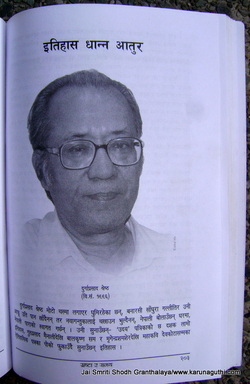
पारसमणि स्मृति पुरस्कार २०१४-का लागि चयनित
श्री दुर्गाप्रसाद श्रेष्ठ - केही शब्द र चित्रहरुमा
प्रस्तोता : राजीव शङ्कर श्रेष्ठ
जन्म – १० जनवरी,१९३९ बनारसमा
माता - स्वर्गीय सुवर्ण कुमारी देवी अनि पिता स्वर्गीय काशीबहादुर श्रेष्ठ
शिक्षा – स्नातक
व्यवसाय – लेखन-सम्पादन / बीचमा नेपाल सरकारको सूचना विभागमा दस सालका लागि सेवारत;
लेखन-विधा – प्रमुखत: कथा विधा
भ्रमण – भारत तथा नेपालका अधिकांश भाग, जापान तथा दक्षिण एशिया
सन् १९३७-मा आफ्ना पिताले संस्थापक-सम्पादक भई शुरुगरेका ऐतिहासिक पत्रिका ‘उदय’ नेपाली साहित्य संकलनलाई निरन्तरता दिँदै हाल अगस्त २०१३-मा १५१ अङ्कसम्म पुरयाउनु नै उहाँको अथक परिश्रम र समर्पण साहित्य-सेवातर्फ मात्र नभई पुत्र-धर्मको असल उदाहरणसाथ पितृ-सेवाको उत्कृष्ट आदर्श लक्ष्य प्रस्तुत|
बनारसमा रहेका नेपालीको छाता संस्था विद्या धर्म प्रचारिणी नेपाली समितिका अध्यक्ष पदमा भर्खरै पुन:निर्वाचित दुर्गाप्रसाद यहाँका तीन धर्मशालाको देखरेखमा सङ्लग्न छन्|
२५ वर्षको उमेरमा ‘उदय’मै ‘जीवन ध्येय’ शीर्षक कविता छपाएर साहित्य सिर्जनामा लागेका उहाँका मौलिक, अनुदित र सम्पादित गरेर एक दर्जन भन्दा बढ़ी कृति प्रकाशित छन् –
नेपाली – ‘सम्झनाको बादल’ (कथा सङ्ग्रह) १९६८ मराठी मा अनुदित-प्रकाशित (१९७८); ‘स्पन्दन’(कविता-सङ्ग्रह) १९७०; ‘उसैको लागि’ – एक अध्ययन (समालोचना) १९७०; ‘उसका अन्तहीन कथा (उपन्यास) १९७२; ‘भाग्यरेखा’ (उपन्यास) १९७३; ‘शेषान्तर’ (उपन्यास) १९७४; ‘कोसेली’(उपन्यास) १९७४; ‘बागमती साक्षी छ’ (उपन्यास) १९८१ र १९९७; ‘काशीमा सप्तर्ष-संगम’ (सम्पादन) बालचन्द्र प्यालेस ट्रस्टको लागि २०००; तृतीय भारत-नेपाल नेपाली लेखक सम्मेलन – २००३ (सम्पादन) बी.पी. कोइराला भारत-नेपाल प्रतिष्ठानको लागि; अनि हालै ‘काशीबहादुर श्रेष्ठ – व्यक्तित्व र कृतित्व (सम्पादन) २०१३ साहित्य अकादमीको लागि; कमला संस्कृतायन – जीवनी (लेखन) २०१४ साहित्य अकादमीको लागि;
हिन्दी – ‘सत्तारे मौसी’ (कथा सङ्ग्रह) १९७३; ‘सोनिया’ (कथा सङ्ग्रह) १९८१; ’३१ चण्डी घोष स्ट्रीट (उपन्यास); देश-देशान्तर (यात्रा-वृत्तान्त) १९९९; ‘माँ कथामृत’ (माता जसजीतजी का जीवन परिचय); यसका अतिरिक्त ‘धर्मयुग’ आदि विभिन्न पत्र-पत्रिकाहरुमा रचनाहरु प्रकाशित; ‘माँ सन्देश’ त्रैमासिक आध्यात्मिक पत्रिका (हिन्दी); हालैमा – स्वर्गीय काशीबहादुर श्रेष्ठद्वारा रचित ‘बसन्त’-को अनुवाद २०१४ साहित्य अकादमीको लागि;
अङ्ग्रेजी – Kashi Bahadur Shrestha – Makers of Indian Literature (Monograph for Sahitya Akademi) 2003
अनुवाद - उहाँका कथाहरु तेलुगु तथा मराठी अनुवाद विभिन्न पत्र-पत्रिकामा प्रकाशित | रुसी भाषामा समेत अनुदित र प्रकाशित;
उहाँले चौदह भाषाहरुमा अनुदितभइसकेको परमहंस योगानन्दजीको ग्रन्थ Autobiography of A Yogi नेपालीमा अनुदित ‘योगदा सत्सङ्ग सोसाइटी अफ् इण्डिया / सेल्फ-रियलाइजेसन फेलोसिप’को लागि २००६
सङ्ग्लनता – सदस्य – अथर्स गिल्ड अफ् इण्डिया, युनाईटेड अथर्स असोसिएसन; अध्यक्ष, विद्या धर्म प्रचारिणी नेपाली समिति, वाराणसी; सदस्य, श्री साम्राज्येश्वर पशुपतिनाथ नेपाली मन्दिर तथा धर्मशाला संचालक समिति; भू.पू. सदस्य, के.के. बिड़ला फाउन्डेशन (भाषा समिति);
सहभागिता – ‘National Convention of Infia Authors’ since 1974; Seminar on ‘Impact of Maithili on Indian Performing Arts, 1998 Kolkata;
आजीवन सदस्य – युनिभर्सल ट्रुथ चेरिटेबल ट्रष्ट लखनऊ, भारत
पुरस्कार – १. उत्तर प्रदेश सरकारद्वारा ‘सत्तारे मौसी’ कथा सङ्ग्रह पुरस्कृत (१९७४); २. नेपाली परिषद्, देहरादूनबाट दीर्घ साहित्य-सेवाक लागि ‘भानु पुरस्कार (१९९२); ३. नेपालका श्री ५ महाराजधिराज वीरेन्द्रबाट सन् नेपाली चलचित्र जगतमा महत्वपूर्ण योगदानका लागि (‘आमा’ चलचित्रमा संवाद लेखे बापत्) ‘चलचित्र कलाधर्मी संघ’को रजत जयन्तीको अवसरमा सम्मान प्रदान (१९९४); ४. ‘कुसुमकुमारी अन्तर्राष्ट्रीय पुरस्कार’ ‘सोनिया’ कथा सङ्ग्रहमा (१९९६); ५. नेपालका युवराजाधिराज श्री ५ दिपेन्द्र बाट नेपाली चलचित्रको क्षेत्रमा योगदानका लागि सम्मानित (१९९९); ‘सहस्राब्दीविश्व हिन्दी सम्मेलन ‘ (नयाँ दिल्ली) द्वारा हिन्दी साहित्य सेवाका लागि ‘राष्ट्रीय हिन्दी सेवक’ उपाधिले सम्मानित (२०००); ७. पानीपत (हरियाणा, भारत)-मा डा. लक्ष्मीनारायण दुबे स्मृति ‘हिन्दी-सेवक’द्वारा सम्मानित (२००१); ८. काठमाडौँ, नेपालमा करुणादेवी स्मारक धर्मार्थ गुठी, सिक्किमद्वारा ‘जय स्मारक सम्मान’-द्वारा पुरस्कृत (२००५); ९. नेपाली साहित्य सम्मेलन, दार्जीलिङद्वारा ’दियालो’ पुरस्कार (२०१२); १०. नेपाली साहित्य अध्ययन समिति, कालेबुङद्वारा पारसमणि स्मृति पुरस्कार (२०१४)
---
सम्पर्क – [email protected]
श्री दुर्गाप्रसाद श्रेष्ठ - केही शब्द र चित्रहरुमा
प्रस्तोता : राजीव शङ्कर श्रेष्ठ
जन्म – १० जनवरी,१९३९ बनारसमा
माता - स्वर्गीय सुवर्ण कुमारी देवी अनि पिता स्वर्गीय काशीबहादुर श्रेष्ठ
शिक्षा – स्नातक
व्यवसाय – लेखन-सम्पादन / बीचमा नेपाल सरकारको सूचना विभागमा दस सालका लागि सेवारत;
लेखन-विधा – प्रमुखत: कथा विधा
भ्रमण – भारत तथा नेपालका अधिकांश भाग, जापान तथा दक्षिण एशिया
सन् १९३७-मा आफ्ना पिताले संस्थापक-सम्पादक भई शुरुगरेका ऐतिहासिक पत्रिका ‘उदय’ नेपाली साहित्य संकलनलाई निरन्तरता दिँदै हाल अगस्त २०१३-मा १५१ अङ्कसम्म पुरयाउनु नै उहाँको अथक परिश्रम र समर्पण साहित्य-सेवातर्फ मात्र नभई पुत्र-धर्मको असल उदाहरणसाथ पितृ-सेवाको उत्कृष्ट आदर्श लक्ष्य प्रस्तुत|
बनारसमा रहेका नेपालीको छाता संस्था विद्या धर्म प्रचारिणी नेपाली समितिका अध्यक्ष पदमा भर्खरै पुन:निर्वाचित दुर्गाप्रसाद यहाँका तीन धर्मशालाको देखरेखमा सङ्लग्न छन्|
२५ वर्षको उमेरमा ‘उदय’मै ‘जीवन ध्येय’ शीर्षक कविता छपाएर साहित्य सिर्जनामा लागेका उहाँका मौलिक, अनुदित र सम्पादित गरेर एक दर्जन भन्दा बढ़ी कृति प्रकाशित छन् –
नेपाली – ‘सम्झनाको बादल’ (कथा सङ्ग्रह) १९६८ मराठी मा अनुदित-प्रकाशित (१९७८); ‘स्पन्दन’(कविता-सङ्ग्रह) १९७०; ‘उसैको लागि’ – एक अध्ययन (समालोचना) १९७०; ‘उसका अन्तहीन कथा (उपन्यास) १९७२; ‘भाग्यरेखा’ (उपन्यास) १९७३; ‘शेषान्तर’ (उपन्यास) १९७४; ‘कोसेली’(उपन्यास) १९७४; ‘बागमती साक्षी छ’ (उपन्यास) १९८१ र १९९७; ‘काशीमा सप्तर्ष-संगम’ (सम्पादन) बालचन्द्र प्यालेस ट्रस्टको लागि २०००; तृतीय भारत-नेपाल नेपाली लेखक सम्मेलन – २००३ (सम्पादन) बी.पी. कोइराला भारत-नेपाल प्रतिष्ठानको लागि; अनि हालै ‘काशीबहादुर श्रेष्ठ – व्यक्तित्व र कृतित्व (सम्पादन) २०१३ साहित्य अकादमीको लागि; कमला संस्कृतायन – जीवनी (लेखन) २०१४ साहित्य अकादमीको लागि;
हिन्दी – ‘सत्तारे मौसी’ (कथा सङ्ग्रह) १९७३; ‘सोनिया’ (कथा सङ्ग्रह) १९८१; ’३१ चण्डी घोष स्ट्रीट (उपन्यास); देश-देशान्तर (यात्रा-वृत्तान्त) १९९९; ‘माँ कथामृत’ (माता जसजीतजी का जीवन परिचय); यसका अतिरिक्त ‘धर्मयुग’ आदि विभिन्न पत्र-पत्रिकाहरुमा रचनाहरु प्रकाशित; ‘माँ सन्देश’ त्रैमासिक आध्यात्मिक पत्रिका (हिन्दी); हालैमा – स्वर्गीय काशीबहादुर श्रेष्ठद्वारा रचित ‘बसन्त’-को अनुवाद २०१४ साहित्य अकादमीको लागि;
अङ्ग्रेजी – Kashi Bahadur Shrestha – Makers of Indian Literature (Monograph for Sahitya Akademi) 2003
अनुवाद - उहाँका कथाहरु तेलुगु तथा मराठी अनुवाद विभिन्न पत्र-पत्रिकामा प्रकाशित | रुसी भाषामा समेत अनुदित र प्रकाशित;
उहाँले चौदह भाषाहरुमा अनुदितभइसकेको परमहंस योगानन्दजीको ग्रन्थ Autobiography of A Yogi नेपालीमा अनुदित ‘योगदा सत्सङ्ग सोसाइटी अफ् इण्डिया / सेल्फ-रियलाइजेसन फेलोसिप’को लागि २००६
सङ्ग्लनता – सदस्य – अथर्स गिल्ड अफ् इण्डिया, युनाईटेड अथर्स असोसिएसन; अध्यक्ष, विद्या धर्म प्रचारिणी नेपाली समिति, वाराणसी; सदस्य, श्री साम्राज्येश्वर पशुपतिनाथ नेपाली मन्दिर तथा धर्मशाला संचालक समिति; भू.पू. सदस्य, के.के. बिड़ला फाउन्डेशन (भाषा समिति);
सहभागिता – ‘National Convention of Infia Authors’ since 1974; Seminar on ‘Impact of Maithili on Indian Performing Arts, 1998 Kolkata;
आजीवन सदस्य – युनिभर्सल ट्रुथ चेरिटेबल ट्रष्ट लखनऊ, भारत
पुरस्कार – १. उत्तर प्रदेश सरकारद्वारा ‘सत्तारे मौसी’ कथा सङ्ग्रह पुरस्कृत (१९७४); २. नेपाली परिषद्, देहरादूनबाट दीर्घ साहित्य-सेवाक लागि ‘भानु पुरस्कार (१९९२); ३. नेपालका श्री ५ महाराजधिराज वीरेन्द्रबाट सन् नेपाली चलचित्र जगतमा महत्वपूर्ण योगदानका लागि (‘आमा’ चलचित्रमा संवाद लेखे बापत्) ‘चलचित्र कलाधर्मी संघ’को रजत जयन्तीको अवसरमा सम्मान प्रदान (१९९४); ४. ‘कुसुमकुमारी अन्तर्राष्ट्रीय पुरस्कार’ ‘सोनिया’ कथा सङ्ग्रहमा (१९९६); ५. नेपालका युवराजाधिराज श्री ५ दिपेन्द्र बाट नेपाली चलचित्रको क्षेत्रमा योगदानका लागि सम्मानित (१९९९); ‘सहस्राब्दीविश्व हिन्दी सम्मेलन ‘ (नयाँ दिल्ली) द्वारा हिन्दी साहित्य सेवाका लागि ‘राष्ट्रीय हिन्दी सेवक’ उपाधिले सम्मानित (२०००); ७. पानीपत (हरियाणा, भारत)-मा डा. लक्ष्मीनारायण दुबे स्मृति ‘हिन्दी-सेवक’द्वारा सम्मानित (२००१); ८. काठमाडौँ, नेपालमा करुणादेवी स्मारक धर्मार्थ गुठी, सिक्किमद्वारा ‘जय स्मारक सम्मान’-द्वारा पुरस्कृत (२००५); ९. नेपाली साहित्य सम्मेलन, दार्जीलिङद्वारा ’दियालो’ पुरस्कार (२०१२); १०. नेपाली साहित्य अध्ययन समिति, कालेबुङद्वारा पारसमणि स्मृति पुरस्कार (२०१४)
---
सम्पर्क – [email protected]
A good book can rewire your brain
by Will Parker
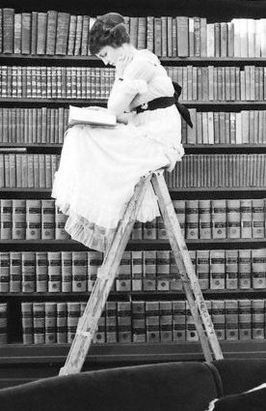 Woman reading in Library
Woman reading in Library
29 December 2013
The scientists behind a novel study into reading say that when we immerse ourselves into a work of fiction, lingering changes occur in the connectivity of our brains. The intriguing new findings, by researchers at Emory University, have been published in the journal Brain Connectivity.
"Stories shape our lives and in some cases help define a person," says neuroscientist Gregory Berns, lead author of the study. "We want to understand how stories get into your brain, and what they do to it." His research, conducted over 19 consecutive days, used functional magnetic resonance imaging (fMRI) to examine the after-effects of reading a "gripping" narrative.
For the study, all the subjects read the novelPompeii, a 2003 thriller by Robert Harris that is based on the real-life eruption of Mount Vesuvius in ancient Italy. Berns says he chose this book because of its page-turning plot. "It depicts true events in a fictional and dramatic way," he explained. "It was important to us that the book had a strong narrative line."
For the first five days, the participants came in each morning for a base-line fMRI scan of their brains in a resting state. Then they were given nine sections of the novel, about 30 pages each, over a nine-day period. They were asked to read the assigned section in the evening, and come in the following morning. After finishing the assigned reading, the participants underwent an fMRI scan of their brain in a non-reading, resting state. After completing all nine sections of the novel, the participants returned for five more mornings to undergo additional scans in a resting state.
Berns says the results showed heightened connectivity in the left temporal cortex, an area of the brain associated with receptivity for language, on the mornings following the reading assignments. "Even though the participants were not actually reading the novel while they were in the scanner, they retained this heightened connectivity," he noted. "We call that a 'shadow activity,' almost like a muscle memory."
Heightened connectivity was also seen in the central sulcus of the brain, the primary sensory motor region of the brain. Neurons of this region have been associated with tricking the mind into thinking it is doing something it is not, a phenomenon known as grounded cognition. "The neural changes that we found associated with physical sensation and movement systems suggest that reading a novel can transport you into the body of the protagonist," Berns says. "We already knew that good stories can put you in someone else's shoes in a figurative sense. Now we're seeing that something may also be happening biologically."
The researchers found the changes persisted for at least the five days of scanning after the participants completed the novel. "It remains an open question how long these neural changes might last," Berns says. "But the fact that we're detecting them over a few days for a randomly assigned novel suggests that your favorite novels could certainly have a bigger and longer-lasting effect on the biology of your brain."
Source: Emory University
The scientists behind a novel study into reading say that when we immerse ourselves into a work of fiction, lingering changes occur in the connectivity of our brains. The intriguing new findings, by researchers at Emory University, have been published in the journal Brain Connectivity.
"Stories shape our lives and in some cases help define a person," says neuroscientist Gregory Berns, lead author of the study. "We want to understand how stories get into your brain, and what they do to it." His research, conducted over 19 consecutive days, used functional magnetic resonance imaging (fMRI) to examine the after-effects of reading a "gripping" narrative.
For the study, all the subjects read the novelPompeii, a 2003 thriller by Robert Harris that is based on the real-life eruption of Mount Vesuvius in ancient Italy. Berns says he chose this book because of its page-turning plot. "It depicts true events in a fictional and dramatic way," he explained. "It was important to us that the book had a strong narrative line."
For the first five days, the participants came in each morning for a base-line fMRI scan of their brains in a resting state. Then they were given nine sections of the novel, about 30 pages each, over a nine-day period. They were asked to read the assigned section in the evening, and come in the following morning. After finishing the assigned reading, the participants underwent an fMRI scan of their brain in a non-reading, resting state. After completing all nine sections of the novel, the participants returned for five more mornings to undergo additional scans in a resting state.
Berns says the results showed heightened connectivity in the left temporal cortex, an area of the brain associated with receptivity for language, on the mornings following the reading assignments. "Even though the participants were not actually reading the novel while they were in the scanner, they retained this heightened connectivity," he noted. "We call that a 'shadow activity,' almost like a muscle memory."
Heightened connectivity was also seen in the central sulcus of the brain, the primary sensory motor region of the brain. Neurons of this region have been associated with tricking the mind into thinking it is doing something it is not, a phenomenon known as grounded cognition. "The neural changes that we found associated with physical sensation and movement systems suggest that reading a novel can transport you into the body of the protagonist," Berns says. "We already knew that good stories can put you in someone else's shoes in a figurative sense. Now we're seeing that something may also be happening biologically."
The researchers found the changes persisted for at least the five days of scanning after the participants completed the novel. "It remains an open question how long these neural changes might last," Berns says. "But the fact that we're detecting them over a few days for a randomly assigned novel suggests that your favorite novels could certainly have a bigger and longer-lasting effect on the biology of your brain."
Source: Emory University
Why at Goa Arts & Literary Festival
Raman Shreshta, in 1979, Raman’s grandfather started Rachna Books in Gangtok. Raman loved the books, enjoyed watching the excitement the bookshop gave to grown-ups and children. However, the bookshop closed down around 1988. After completing his education, and a job in the corporarte world, Raman’s soul-searching brought himback to his roots and in 2001, he started Rachna Books.
Now almost twelve years running, Raman’s bookshop has grown fourfold in size from those early days, has added ‘Café Fiction’ downstairs and a B&B upstairs making Rachna’s a vibrant cultural landmark in Sikkim. They now organize events ranging from readings, talks, exhibitions, screening, installation art shows, book-launches, worshops, plays and musicals.
Source : IV Edition Goa Arts & Literary Festival 5-8 December 2013
Now almost twelve years running, Raman’s bookshop has grown fourfold in size from those early days, has added ‘Café Fiction’ downstairs and a B&B upstairs making Rachna’s a vibrant cultural landmark in Sikkim. They now organize events ranging from readings, talks, exhibitions, screening, installation art shows, book-launches, worshops, plays and musicals.
Source : IV Edition Goa Arts & Literary Festival 5-8 December 2013
Ayurveda approach towards diabetes

Ayurveda approach towards diabetes
Multi-pronged approach to diabetes looks at three doshas and the everyday symptoms in each
By Binu Savan, Special to Gulf News (Published: 10:00 August 8, 2013)
What exactly is diabetes?
Diabetes in, very simplistic terms, can be defined as excess of glucose in the blood. When you consume food, your blood sugar levels rise. The rising blood sugar levels, the pancreas release the hormone insulin into your bloodstream.
The presence of insulin in your blood is the signal for your muscles, liver and fat cells to take up glucose from your bloodstream, where it is stored as glycogen, a principle source of energy for your body.
However, diabetes occurs when the pancreas fails to produce sufficient amounts of insulin and because diabetics lack sufficient insulin or are unresponsive to insulin, blood sugar levels remain high. If diabetes is not managed properly, it can lead to complications like heart attacks, strokes, blindness, nerve damage, amputation of limbs, impotence in men and pruritus (itching).
Type 1 Diabetes Mellitus also known as juvenile diabetes or insulin-dependent diabetes occurs due to the autoimmune destruction of the insulin producing cells of the pancreas resulting in increased blood and urine glucose levels. The symptoms for this are frequent urination, increased thirst and hunger and weight loss.
Type 2 Diabetes Mellitus also known as adult-onset diabetes or non-insulin-dependent diabetes is characterised by insulin resistance and deficiency. However, the cause for this is primarily rooted in lifestyle issues like increasing stress, sedentary living and an unhealthy diet, as well as genetics.
The symptoms for this are similar to Type 1’s and also include fatigue, vision changes, slow healing from cuts and wounds and skin changes. Type 2 diabetes can be controlled with proper diet and exercise and treatment.
Ayurveda and diabetes
In Ayurveda, Diabetes is called Prameha. Unlike modern science that divides diabetes into two categories, Ayurveda further divides prameha or diabetes into 20 sub-divisions. These sub-divisions are based on doshas with 4 divisions due to Vata, 6 due to Pitta and 10 rooted in Kapha dosha.
The main and most common sub-division is the one rooted in Kapha dosha. Prameha when not treated leads to Madhumeha or Diabetes Mellitus (Type 2). According to Ayurveda the primary cause of Prameha and Madhumeha are an unhealthy diet that aggravates the Kapha dosha, lack of exercise, excessive sleep and stress. Ayurveda also points out that besides the symptoms mentioned earlier, one must also look out for burning of palms and soles, dryness of mouth and a sweet taste in the mouth.
In Ayurveda, Prameha and Madhumeha are divided into 20 sub-categories based on the doshas. The three main divisions are the Kaphaja, Pittaja and Vataja. The symptoms experienced by these three divisions if they are suffering from diabetes are as follows;
Kaphaja: Indigestion, loss of appetite, cold with running nose, excessive sleep, vomiting tendency.
Pittaja: Pain in bladder and urinary tract, pain in testes, fever, burning sensation, thirst, acidity. giddiness, loose motion, loss of sleep.
Vataja: Tremors, insomnia, cough, difficulty in breathing, constipation, wasting away.
Diabetic diet
Ayurvedic practitioners have a multi-pronged approach to diabetes. Ayurveda, too, recommends lifestyle remedies that include limiting foods that are high in sugar and simple carbohydrates, eating smaller portions through the day, eating a variety of whole-grain foods, complex carbohydrates and vegetables every day, less fat and using less salt. It is also important to avoid smoking, reduce intake of alcohol, sleep adequately, check blood sugar levels periodically, check weight periodically and maintain ideal body weight.
Ideally, your food proportion should be 60% vegetables, 30% protein, 10% carbohydrates with half an hour of mild exercise such as walking. The diet should be a Kapha-pacifying diet and should include protein-rich foods like soya bean products and lentils like chickpea, moong, masoor and vegetables like spinach, leafy greens, bottle gourd, turai, bhopla (white pumpkin), snake gourd and bitter gourd and, cereals like green millet, ragi, corn, horse gram and barley.
Intake of protein should, however, be limited as it can strain the kidneys. Similarly, limit the intake of fat as the deficiency of pancreatic enzymes makes digestion of fat difficult. A diabetic should avoid eating rice, potato, sweet fruits, white flour, wheat, red meat and sago. He or she should also avoid sugar, sugar cane, jaggery and juices of sweet fruits. In terms of fruits, oranges and lemon are good.
Herbs
Herbal remedies, if taken correctly, have a powerful effect on your body but should only be used under the care and guidance of an Ayurvedic practitioner. These include Jambhul (Eugenia jambolana) powder from jamun core, Guggul, Amalaki, Triphala, Shilajit, Gurmar (gymnema sylvestre) and Bel (Aegle marmelos) Most of these herbs target elevated blood sugar levels and balance the same. In fact, some herbs like stevia and liquorice, are also used as a sugar substitute.
Treatment
Besides herbal medication, Ayurveda recommends the Panchakarma as a cleansing treatment program. The Panchakarma begins with an herbal massage and an herbal steam sauna followed by fasting to cleanse the body. This is followed by an herbal purge for the liver, pancreas and spleen and this is further followed by colon therapy which cleanses the digestive tract and reconstitutes the system.
Snehana and shodhana are also the basic treatment methods which are employed dependent on the condition and body type of the patient. The Shamana treatment is given after the above mentioned treatments, and uses combinations of herbal medications.
Exercise
Daily exercise is necessary to manage diabetes. Yoga is beneficial, especially asanas like Paschimottanasana and Halasana and Pranayama and Vajrasana.
Binu Sivan is a Dubai-based freelance writer
___
Fact Box
The ideal diet for a diabetic
60% vegetables
30% protein
10% carbohydrates
DIABETES NUMBERS
366 million People have diabetes in 2011
552 million People will have diabetes by 2030.
The number of people with type 2 diabetes is increasing in every country
40-59 years The age span with the highest number of people with diabetes.
183 million people (50%) With diabetes are as yet undiagnosed.
Diabetes caused
4.6 million
The deaths caused in 2011 by diabetes.
78,000
The number of children who develop type 1 diabetes every year.
(According to the International Diabetes Federation (IDF)).
DID YOU KNOW?
A six-month trial on 63 diabetes patients by a hospital in India (Sassoon General Hospital) showed that Ayurvedic treatment resulted in 46 of them experiencing a significant decrease in their blood sugar levels. One out of 14 Type 1 diabetic patients was able to handle Type 1 diabetes without insulin after getting on the Ayurvedic treatment program. Nine other Type 1 patients have been able to decrease their insulin dosage from 35 units to 21.6 units. The positive results were even more astounding in the case of those suffering from Type 2 diabetes. 19 patients on the trial were able to completely stop their allopathic medications while 14 others could reduce their dosage after 180 days on the Ayurvedic treatment that included the herbal medication Madhusar.
7 Effective Home Remedies for Controlling Sugar
Ayurveda recommends many simple home remedies to keep diabetes under control. Incorporating one or two of these remedies into your daily diet plan can help you prevent or at the least manage your blood glucose levels.
1. Mix half a teaspoon of turmeric powder + 1 teaspoon of amla powder + half a tablespoon of methi seeds powder in half a glass of water and take daily in the morning on an empty stomach.
2. Mix honey with barley that is soaked overnight in Triphala decoction (available at Ayurveda stores) and have it several times during the day.
3.Juice of bitter melon or gourd can test the toughest amongst us. But when taken on an empty stomach it works wonders at balancing our blood sugar level.
4.Grind and mix 100gms of fenugreek (methi) seeds, 50gms of turmeric and some white pepper. Take one teaspoon of this powder with a glass of milk twice daily.
5.Soak one teaspoon of fenugreek overnight in water and drink it with water or milk in the morning.
6.A tablespoon of the juice of the Indian gooseberry mixed with a cup of fresh bitter gourd juice is said to enable the pancreas to secrete insulin, if it is taken daily for two months.
7.Drink a glass of water with 10 tulsi leaves, 10 belpatras and fenugreek leaves early in the morning on an empty stomach.
___
Disclaimer : Shared on the eve of World Diabetes Day 2013 for general information of our readers.
___
Multi-pronged approach to diabetes looks at three doshas and the everyday symptoms in each
By Binu Savan, Special to Gulf News (Published: 10:00 August 8, 2013)
What exactly is diabetes?
Diabetes in, very simplistic terms, can be defined as excess of glucose in the blood. When you consume food, your blood sugar levels rise. The rising blood sugar levels, the pancreas release the hormone insulin into your bloodstream.
The presence of insulin in your blood is the signal for your muscles, liver and fat cells to take up glucose from your bloodstream, where it is stored as glycogen, a principle source of energy for your body.
However, diabetes occurs when the pancreas fails to produce sufficient amounts of insulin and because diabetics lack sufficient insulin or are unresponsive to insulin, blood sugar levels remain high. If diabetes is not managed properly, it can lead to complications like heart attacks, strokes, blindness, nerve damage, amputation of limbs, impotence in men and pruritus (itching).
Type 1 Diabetes Mellitus also known as juvenile diabetes or insulin-dependent diabetes occurs due to the autoimmune destruction of the insulin producing cells of the pancreas resulting in increased blood and urine glucose levels. The symptoms for this are frequent urination, increased thirst and hunger and weight loss.
Type 2 Diabetes Mellitus also known as adult-onset diabetes or non-insulin-dependent diabetes is characterised by insulin resistance and deficiency. However, the cause for this is primarily rooted in lifestyle issues like increasing stress, sedentary living and an unhealthy diet, as well as genetics.
The symptoms for this are similar to Type 1’s and also include fatigue, vision changes, slow healing from cuts and wounds and skin changes. Type 2 diabetes can be controlled with proper diet and exercise and treatment.
Ayurveda and diabetes
In Ayurveda, Diabetes is called Prameha. Unlike modern science that divides diabetes into two categories, Ayurveda further divides prameha or diabetes into 20 sub-divisions. These sub-divisions are based on doshas with 4 divisions due to Vata, 6 due to Pitta and 10 rooted in Kapha dosha.
The main and most common sub-division is the one rooted in Kapha dosha. Prameha when not treated leads to Madhumeha or Diabetes Mellitus (Type 2). According to Ayurveda the primary cause of Prameha and Madhumeha are an unhealthy diet that aggravates the Kapha dosha, lack of exercise, excessive sleep and stress. Ayurveda also points out that besides the symptoms mentioned earlier, one must also look out for burning of palms and soles, dryness of mouth and a sweet taste in the mouth.
In Ayurveda, Prameha and Madhumeha are divided into 20 sub-categories based on the doshas. The three main divisions are the Kaphaja, Pittaja and Vataja. The symptoms experienced by these three divisions if they are suffering from diabetes are as follows;
Kaphaja: Indigestion, loss of appetite, cold with running nose, excessive sleep, vomiting tendency.
Pittaja: Pain in bladder and urinary tract, pain in testes, fever, burning sensation, thirst, acidity. giddiness, loose motion, loss of sleep.
Vataja: Tremors, insomnia, cough, difficulty in breathing, constipation, wasting away.
Diabetic diet
Ayurvedic practitioners have a multi-pronged approach to diabetes. Ayurveda, too, recommends lifestyle remedies that include limiting foods that are high in sugar and simple carbohydrates, eating smaller portions through the day, eating a variety of whole-grain foods, complex carbohydrates and vegetables every day, less fat and using less salt. It is also important to avoid smoking, reduce intake of alcohol, sleep adequately, check blood sugar levels periodically, check weight periodically and maintain ideal body weight.
Ideally, your food proportion should be 60% vegetables, 30% protein, 10% carbohydrates with half an hour of mild exercise such as walking. The diet should be a Kapha-pacifying diet and should include protein-rich foods like soya bean products and lentils like chickpea, moong, masoor and vegetables like spinach, leafy greens, bottle gourd, turai, bhopla (white pumpkin), snake gourd and bitter gourd and, cereals like green millet, ragi, corn, horse gram and barley.
Intake of protein should, however, be limited as it can strain the kidneys. Similarly, limit the intake of fat as the deficiency of pancreatic enzymes makes digestion of fat difficult. A diabetic should avoid eating rice, potato, sweet fruits, white flour, wheat, red meat and sago. He or she should also avoid sugar, sugar cane, jaggery and juices of sweet fruits. In terms of fruits, oranges and lemon are good.
Herbs
Herbal remedies, if taken correctly, have a powerful effect on your body but should only be used under the care and guidance of an Ayurvedic practitioner. These include Jambhul (Eugenia jambolana) powder from jamun core, Guggul, Amalaki, Triphala, Shilajit, Gurmar (gymnema sylvestre) and Bel (Aegle marmelos) Most of these herbs target elevated blood sugar levels and balance the same. In fact, some herbs like stevia and liquorice, are also used as a sugar substitute.
Treatment
Besides herbal medication, Ayurveda recommends the Panchakarma as a cleansing treatment program. The Panchakarma begins with an herbal massage and an herbal steam sauna followed by fasting to cleanse the body. This is followed by an herbal purge for the liver, pancreas and spleen and this is further followed by colon therapy which cleanses the digestive tract and reconstitutes the system.
Snehana and shodhana are also the basic treatment methods which are employed dependent on the condition and body type of the patient. The Shamana treatment is given after the above mentioned treatments, and uses combinations of herbal medications.
Exercise
Daily exercise is necessary to manage diabetes. Yoga is beneficial, especially asanas like Paschimottanasana and Halasana and Pranayama and Vajrasana.
Binu Sivan is a Dubai-based freelance writer
___
Fact Box
The ideal diet for a diabetic
60% vegetables
30% protein
10% carbohydrates
DIABETES NUMBERS
366 million People have diabetes in 2011
552 million People will have diabetes by 2030.
The number of people with type 2 diabetes is increasing in every country
40-59 years The age span with the highest number of people with diabetes.
183 million people (50%) With diabetes are as yet undiagnosed.
Diabetes caused
4.6 million
The deaths caused in 2011 by diabetes.
78,000
The number of children who develop type 1 diabetes every year.
(According to the International Diabetes Federation (IDF)).
DID YOU KNOW?
A six-month trial on 63 diabetes patients by a hospital in India (Sassoon General Hospital) showed that Ayurvedic treatment resulted in 46 of them experiencing a significant decrease in their blood sugar levels. One out of 14 Type 1 diabetic patients was able to handle Type 1 diabetes without insulin after getting on the Ayurvedic treatment program. Nine other Type 1 patients have been able to decrease their insulin dosage from 35 units to 21.6 units. The positive results were even more astounding in the case of those suffering from Type 2 diabetes. 19 patients on the trial were able to completely stop their allopathic medications while 14 others could reduce their dosage after 180 days on the Ayurvedic treatment that included the herbal medication Madhusar.
7 Effective Home Remedies for Controlling Sugar
Ayurveda recommends many simple home remedies to keep diabetes under control. Incorporating one or two of these remedies into your daily diet plan can help you prevent or at the least manage your blood glucose levels.
1. Mix half a teaspoon of turmeric powder + 1 teaspoon of amla powder + half a tablespoon of methi seeds powder in half a glass of water and take daily in the morning on an empty stomach.
2. Mix honey with barley that is soaked overnight in Triphala decoction (available at Ayurveda stores) and have it several times during the day.
3.Juice of bitter melon or gourd can test the toughest amongst us. But when taken on an empty stomach it works wonders at balancing our blood sugar level.
4.Grind and mix 100gms of fenugreek (methi) seeds, 50gms of turmeric and some white pepper. Take one teaspoon of this powder with a glass of milk twice daily.
5.Soak one teaspoon of fenugreek overnight in water and drink it with water or milk in the morning.
6.A tablespoon of the juice of the Indian gooseberry mixed with a cup of fresh bitter gourd juice is said to enable the pancreas to secrete insulin, if it is taken daily for two months.
7.Drink a glass of water with 10 tulsi leaves, 10 belpatras and fenugreek leaves early in the morning on an empty stomach.
___
Disclaimer : Shared on the eve of World Diabetes Day 2013 for general information of our readers.
___
Gai Jatra
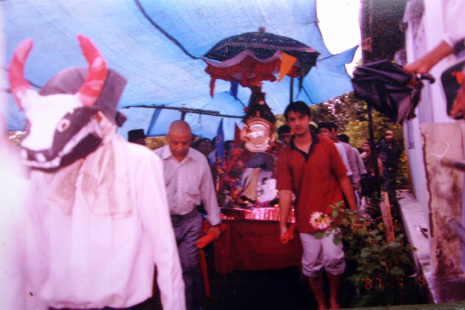
Gai Jatra/Procession starts from home to Sri 3 Dhaneshwar Shivalaya Mahadev Mandir
Gai Jatra
Of the other most typical festivals among the Newars, one is the Gai Jatra which is not met with in any other community. This is known in Newari as Sa-ya-wane-gu. Sa means cow; ya represents jatra and wane-gu means “to go”. It takes [place on the first of the dark-half of Bhadra (Aug-Sep). The usual belief connected with it is that from the Sithi Nakha day ( the 10th of the bright-half of Jaistha), the day when the worship of Dewali comes to an end, the gates of the kingdom of Yama are closed and, therefore, who die after that date are unable to get admission to heaven. The festival of cow is, therefore, designed to help the dead souls to enter Yama’s kingdom or heaven. As the belief runs, on the cow festival day, the cow is able to thrust open one of the doors of Yama’s abode with its horns, while the other door is believed to be opened to be later on the Vanra Jatra day 9 the 13th of the dark-half of Bhadra).
On the day of this festival, families in which a death had occurred after the last Sithi Nakha day send out two boys in the guise of a pair of cows. Usually small children are picked up for this purpose. They wear paper caps, on which are depicted cow’s horns, and go round the streets accompanied by different types of music provided by the various Newar castes.
Those who impersonate the cows are first worshippedin the house itself. Then they go out to join other cow-mask wearers in the streets. Cow-mask wearers are called Sa-ya-wa-pi. They walk with unfurled colourful umbrellas, specially made for the occasion. There are also other types of mask-wearers who are intended to provide fun. These cow-mask wearers are followed by their relatives who wear white scarfs round their necks. As the procession moves forward through the prescribed route it begins to swell with the addition of more and more of such masqueraders on the way.
The procession halts at places to receive fruits on behalf of those families wherein somebody has died. The frit offerings invariably include sugarcane and oranges.
After returning from the rounds, the masks are taken off and hung at the main temples of each locality. continued ...2
Of the other most typical festivals among the Newars, one is the Gai Jatra which is not met with in any other community. This is known in Newari as Sa-ya-wane-gu. Sa means cow; ya represents jatra and wane-gu means “to go”. It takes [place on the first of the dark-half of Bhadra (Aug-Sep). The usual belief connected with it is that from the Sithi Nakha day ( the 10th of the bright-half of Jaistha), the day when the worship of Dewali comes to an end, the gates of the kingdom of Yama are closed and, therefore, who die after that date are unable to get admission to heaven. The festival of cow is, therefore, designed to help the dead souls to enter Yama’s kingdom or heaven. As the belief runs, on the cow festival day, the cow is able to thrust open one of the doors of Yama’s abode with its horns, while the other door is believed to be opened to be later on the Vanra Jatra day 9 the 13th of the dark-half of Bhadra).
On the day of this festival, families in which a death had occurred after the last Sithi Nakha day send out two boys in the guise of a pair of cows. Usually small children are picked up for this purpose. They wear paper caps, on which are depicted cow’s horns, and go round the streets accompanied by different types of music provided by the various Newar castes.
Those who impersonate the cows are first worshippedin the house itself. Then they go out to join other cow-mask wearers in the streets. Cow-mask wearers are called Sa-ya-wa-pi. They walk with unfurled colourful umbrellas, specially made for the occasion. There are also other types of mask-wearers who are intended to provide fun. These cow-mask wearers are followed by their relatives who wear white scarfs round their necks. As the procession moves forward through the prescribed route it begins to swell with the addition of more and more of such masqueraders on the way.
The procession halts at places to receive fruits on behalf of those families wherein somebody has died. The frit offerings invariably include sugarcane and oranges.
After returning from the rounds, the masks are taken off and hung at the main temples of each locality. continued ...2
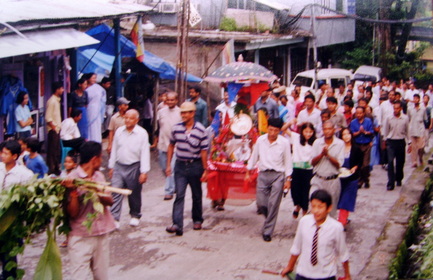
Gai Jatra/Procession arrives Rhenock Bazar
The festival of cow is also marked by some regional variation. Compared with its celebration in the towns, it is more traditionally observed by the people of rural areas. Unlike in Kathmandu town, at Panga this festival is organized on a community level involving wholesale participation of the village. And one long procession is taken out. For this, all the cow masqueraders meet at an appointed place from where the procession starts. Every family, which sends out mask wearers makes an additional provision for subsidiary types of mask wearers. Mask wearers of each family are followed by another mask wearer who holds the tails of the former, and he in turn is followed by yet another mask-man who carries a plough. (It is quite strange to find the plough forming a ritual object when its use is tabooed among the Newars).
Having assembled at the place, the procession is arranged in a definite order or precedence. The mask-men and their party are followed by a fish-mask wearer who drags on his left and right two brooms which hang fro his waist. Next to him is a mask-man (with any kind of mask), who drags about a copper utensil on one side and a tiny cot on the other. He is followed by another masquerader, dragging along with him a wooden-stand called Dui-Khutte.(A wooden stand on which Dheki (mortar for pounding rice). He is followed by a mask-man who drags along with him five worn-out clay-vessels, which are generally used for storing oil. The mask of this person is made of mushrooms.
Then comes in order the Dhaka-Ghisa to take place, He wears any kind of mask and drags a big basket used for keeping hen. The next place is occupied by a mask-man who does not belong to Panga but to the nearby town of Kirtipur. He is required to pay, according to custom, eight annas and a pice for representing his community in the procession. He is turn followed by masqueraders, each of whom gird their loins with nine saris, nine blouses and nine handkerchiefs. Then separate groups of traditional musicians, hailing respectively, from the Jyapoo, Kasai and Kusle castes arrange themselves in that order. With such paraphernalias, the procession starts with loud music, which leads vigour to the entire function.
The procession first goes to the village temple of Ganesh; from there to the Lachhi Tole to pay respect to Buddha and Narain; and thereafter to different streets and lanes. After going round Panga settlement, it proceeds to the adjoining villages of Naigam and Chhagam, both of which form a part of the Panga community. On its return to Panga, the procession stops
at the village tank, where people indulge in merriments and dance, in which all mask-wearers participate. When they return home, the mask-wearers are worshipped at the entrance of the house. The usual feast is held thereafter
In the evening again, they assemble at the central square to witness the lakhe dance. The Kusle priest sacrifices a hen to Ganesh by wringing its neck. Then he jumps into the tank and the sacrificed hen is taken away by him. Afterwards about two or three hundred stacks of maize cobs are thrown into the tank which are immediately picked up by persons who would be swimming in the tank to get hold of them. It is follwed by the distribution of piece of buffalo skin to each group of the musicians. In addition, a piece of the sacrificed buffalo’s leg is given to the heads of the eight groups of musicians. As soon as they receive the pieces of skin and legs, they jump into the tank. The lakhe dancer is given the buffalo’s head; but he does not leap into the tank. Instead, he circumambulates it, In the former days the buffalo’s head used to be a source of conflict between the two lakhe dancers; for each would claim the right side of the head. In the year (1957) to which the above description alludes, there was, however, only one lakhe dancer.
Even outside the Valley, the cow-festival is popular among the Newars. But it varies somewhat in detail. For example, in Charikot, the festival is marked by taking out in procession the effigies of the dead relatives while in Dhankuta the cow-mask is replaced by real cows.
The festival of cow, thus it is seen, is not designed for material gains as in the case of Bhairava and Bhairavi festivals. Rather, it is aimed at fulfilling one’s obligation towards the dead relatives In the former days, as Oaldfield records ( Oalfield, H.A. - Sketches from Nipal, Vol.II, p38), the cow festival was associated with the festival of tiger-dancers, which had by his time become a repetition of Gai Jatra.
---
Courtesy: Dr. Gopal Singh Nepali: The Newars - “Festivals–Community Events” (pages 353-357) – materials collected and submitted to the University of Bombay in 1959 for his Ph.D.thesis: Revised Edition 1988 Himalayan Booksellers, Kathmandu, Nepal.
---
Pictures shown are of Gai Jatra Procession 2003 in memory of our Founder/Father Jai Shanker Lall Shresta (1917-2003) at Rhenock, Sikkim
---
Having assembled at the place, the procession is arranged in a definite order or precedence. The mask-men and their party are followed by a fish-mask wearer who drags on his left and right two brooms which hang fro his waist. Next to him is a mask-man (with any kind of mask), who drags about a copper utensil on one side and a tiny cot on the other. He is followed by another masquerader, dragging along with him a wooden-stand called Dui-Khutte.(A wooden stand on which Dheki (mortar for pounding rice). He is followed by a mask-man who drags along with him five worn-out clay-vessels, which are generally used for storing oil. The mask of this person is made of mushrooms.
Then comes in order the Dhaka-Ghisa to take place, He wears any kind of mask and drags a big basket used for keeping hen. The next place is occupied by a mask-man who does not belong to Panga but to the nearby town of Kirtipur. He is required to pay, according to custom, eight annas and a pice for representing his community in the procession. He is turn followed by masqueraders, each of whom gird their loins with nine saris, nine blouses and nine handkerchiefs. Then separate groups of traditional musicians, hailing respectively, from the Jyapoo, Kasai and Kusle castes arrange themselves in that order. With such paraphernalias, the procession starts with loud music, which leads vigour to the entire function.
The procession first goes to the village temple of Ganesh; from there to the Lachhi Tole to pay respect to Buddha and Narain; and thereafter to different streets and lanes. After going round Panga settlement, it proceeds to the adjoining villages of Naigam and Chhagam, both of which form a part of the Panga community. On its return to Panga, the procession stops
at the village tank, where people indulge in merriments and dance, in which all mask-wearers participate. When they return home, the mask-wearers are worshipped at the entrance of the house. The usual feast is held thereafter
In the evening again, they assemble at the central square to witness the lakhe dance. The Kusle priest sacrifices a hen to Ganesh by wringing its neck. Then he jumps into the tank and the sacrificed hen is taken away by him. Afterwards about two or three hundred stacks of maize cobs are thrown into the tank which are immediately picked up by persons who would be swimming in the tank to get hold of them. It is follwed by the distribution of piece of buffalo skin to each group of the musicians. In addition, a piece of the sacrificed buffalo’s leg is given to the heads of the eight groups of musicians. As soon as they receive the pieces of skin and legs, they jump into the tank. The lakhe dancer is given the buffalo’s head; but he does not leap into the tank. Instead, he circumambulates it, In the former days the buffalo’s head used to be a source of conflict between the two lakhe dancers; for each would claim the right side of the head. In the year (1957) to which the above description alludes, there was, however, only one lakhe dancer.
Even outside the Valley, the cow-festival is popular among the Newars. But it varies somewhat in detail. For example, in Charikot, the festival is marked by taking out in procession the effigies of the dead relatives while in Dhankuta the cow-mask is replaced by real cows.
The festival of cow, thus it is seen, is not designed for material gains as in the case of Bhairava and Bhairavi festivals. Rather, it is aimed at fulfilling one’s obligation towards the dead relatives In the former days, as Oaldfield records ( Oalfield, H.A. - Sketches from Nipal, Vol.II, p38), the cow festival was associated with the festival of tiger-dancers, which had by his time become a repetition of Gai Jatra.
---
Courtesy: Dr. Gopal Singh Nepali: The Newars - “Festivals–Community Events” (pages 353-357) – materials collected and submitted to the University of Bombay in 1959 for his Ph.D.thesis: Revised Edition 1988 Himalayan Booksellers, Kathmandu, Nepal.
---
Pictures shown are of Gai Jatra Procession 2003 in memory of our Founder/Father Jai Shanker Lall Shresta (1917-2003) at Rhenock, Sikkim
---
World Heart Day 29 September 2012

Cardiovascular diseases are the world’s largest killers, claiming 17.3 million lives a year. Risk factors for heart disease and stroke include raised blood pressure, cholesterol and glucose levels, smoking, inadequate intake of fruit and vegetables, overweight, obesity and physical inactivity.
In partnership with WHO, the World Heart Federation organizes awareness events in more than 100 countries - including health checks, organized walks, runs and fitness sessions, public talks, stage shows, scientific forums, exhibitions, concerts, carnivals and sports tournaments. Source : WHO
Your heart is in your hands
DR. D. K. SATSANGI
Live a heart-healthy life...
With this year’s theme for World Heart Day (September 29) being heart disease in women and children, here is an alert on what to look out for.
Do you smoke, drink or lead a sedentary life? Do you have high blood pressure, sugar or cholesterol levels? Are you under stress due to personal or professional problems? Do you think you are suffering from Cardiovascular-Disease (CVD)? These questions are largely applicable to most people but are extremely crucial when it comes to women.
Why? The answer lies in the exponential increase in the incidence of CVDs among women. The death rate due to cardiac disease among women has increased from 30 per cent in 1997 to 54 per cent in 2009 and the myth that heart disease is a ‘man’s disease’ has been debunked.
Underestimated
Almost half of the 17.3 million annual CVD’s deaths occur in women, though the risk is often underestimated. If you ask women about the greatest health problem they face, the majority would say breast cancer. But it is CVD, which poses the greatest health problem for women today. It claims the lives of more women than all forms of cancer combined.
Children are also at risk since they have little control over their environment and their heart-healthy choices can be limited. The other reason is Congenital heart defect (CHD). This is caused by improper development of the heart during foetal development. Mothers who do not adhere to the special diet necessary to manage the disease during pregnancy have a higher risk of having a child with congenital heart disease. Women with insulin-dependent diabetes may have a higher risk of having a child with heart defects.
The most common cause of CVD is Atherosclerosis (hardening/clogging of arteries caused by the build-up of cholesterol and fatty deposits (called plaque) on the inner walls of the arteries. This restricts blood flow to the heart.
Without adequate blood, the heart is starved of oxygen and the vital nutrients it needs to work properly. When one or more of the coronary arteries becomes blocked, a heart attack (injury to the heart muscle) can occur.
The most important challenge is to identify the symptoms in women because these are often different (see box). Sixty four per cent of women who died suddenly because of coronary heart disease had no previous symptoms. The symptoms may occur with or without chest pain and may come and go.
Risk factors
Older age: When woman reaches the age of 50-52 (the age of natural menopause), the risk of heart disease increases dramatically
Family history: If your parents have CVDs, you have an increased risk of developing it
Race: Risk of CVDs varies with race. For example, Afro-Americans have more severe high blood pressure than Caucasians and are at higher risk of CVDs. This is partly due to higher rates of obesity and diabetes in these populations.
Remember, CVD is largely preventable. You can ensure your heart stays healthy by following a healthy lifestyle. Your heart is in your hands.
Symptoms in women
A feeling of being squeezed or discomfort/pain in the chest, between the breasts or behind the breastbone
Discomfort and/or radiating pain over arms, back, neck, jaw or stomach
Shortness of breath, weakness or fatigue
Unusual anxiety or nervousness
Indigestion or gas-like pain, nausea
Sudden sweating, dizziness and collapse
What you can do
Be physically active, walk or work out regularly
Avoid foods full of salt, saturated and trans fats and sugar. Eat lots of fruit and vegetables
Maintain a healthy weight
Quit smoking and avoid respiratory irritants
Limit or stop alcohol use
Stop smoking, avoid products containing tobacco
Those with lung problems should get annual influenza vaccination
Source Shared from The Hindu Photo: Special Arrangement
In partnership with WHO, the World Heart Federation organizes awareness events in more than 100 countries - including health checks, organized walks, runs and fitness sessions, public talks, stage shows, scientific forums, exhibitions, concerts, carnivals and sports tournaments. Source : WHO
Your heart is in your hands
DR. D. K. SATSANGI
Live a heart-healthy life...
With this year’s theme for World Heart Day (September 29) being heart disease in women and children, here is an alert on what to look out for.
Do you smoke, drink or lead a sedentary life? Do you have high blood pressure, sugar or cholesterol levels? Are you under stress due to personal or professional problems? Do you think you are suffering from Cardiovascular-Disease (CVD)? These questions are largely applicable to most people but are extremely crucial when it comes to women.
Why? The answer lies in the exponential increase in the incidence of CVDs among women. The death rate due to cardiac disease among women has increased from 30 per cent in 1997 to 54 per cent in 2009 and the myth that heart disease is a ‘man’s disease’ has been debunked.
Underestimated
Almost half of the 17.3 million annual CVD’s deaths occur in women, though the risk is often underestimated. If you ask women about the greatest health problem they face, the majority would say breast cancer. But it is CVD, which poses the greatest health problem for women today. It claims the lives of more women than all forms of cancer combined.
Children are also at risk since they have little control over their environment and their heart-healthy choices can be limited. The other reason is Congenital heart defect (CHD). This is caused by improper development of the heart during foetal development. Mothers who do not adhere to the special diet necessary to manage the disease during pregnancy have a higher risk of having a child with congenital heart disease. Women with insulin-dependent diabetes may have a higher risk of having a child with heart defects.
The most common cause of CVD is Atherosclerosis (hardening/clogging of arteries caused by the build-up of cholesterol and fatty deposits (called plaque) on the inner walls of the arteries. This restricts blood flow to the heart.
Without adequate blood, the heart is starved of oxygen and the vital nutrients it needs to work properly. When one or more of the coronary arteries becomes blocked, a heart attack (injury to the heart muscle) can occur.
The most important challenge is to identify the symptoms in women because these are often different (see box). Sixty four per cent of women who died suddenly because of coronary heart disease had no previous symptoms. The symptoms may occur with or without chest pain and may come and go.
Risk factors
Older age: When woman reaches the age of 50-52 (the age of natural menopause), the risk of heart disease increases dramatically
Family history: If your parents have CVDs, you have an increased risk of developing it
Race: Risk of CVDs varies with race. For example, Afro-Americans have more severe high blood pressure than Caucasians and are at higher risk of CVDs. This is partly due to higher rates of obesity and diabetes in these populations.
Remember, CVD is largely preventable. You can ensure your heart stays healthy by following a healthy lifestyle. Your heart is in your hands.
Symptoms in women
A feeling of being squeezed or discomfort/pain in the chest, between the breasts or behind the breastbone
Discomfort and/or radiating pain over arms, back, neck, jaw or stomach
Shortness of breath, weakness or fatigue
Unusual anxiety or nervousness
Indigestion or gas-like pain, nausea
Sudden sweating, dizziness and collapse
What you can do
Be physically active, walk or work out regularly
Avoid foods full of salt, saturated and trans fats and sugar. Eat lots of fruit and vegetables
Maintain a healthy weight
Quit smoking and avoid respiratory irritants
Limit or stop alcohol use
Stop smoking, avoid products containing tobacco
Those with lung problems should get annual influenza vaccination
Source Shared from The Hindu Photo: Special Arrangement
World Heart Day 2011
Keep your heart healthy and strong
World Heart Day - A healthy heart for a healthy lifestyle
How important is it to keep your heart healthy? According to World Health Organization (WHO), every year heart diseases claim 17.3 million people around the world. The World Heart Day is observed to make people realize the risk of heart diseases and enlighten that such death could be avoided by adopting simple and easy ways. World Heart Day is usually observed on the last Sunday of September every year, but as of this year, World Heart Day 2011 will be celebrated on September 29 that also marks its eleventh anniversary.
The World Heart Day is organized by World Heart Federation, a non-governmental organization with its headquaters in Geneva, Switzerland, endorsed by World Health Organization and other organizations. It identifies the numerous factors responsible for the cardiovascular diseases and premature deaths. World Heart Federation also spreads the news on how stroke and heart diseases could be avoided if physical activities and unhealthy diets are controlled.
World Heart Federation also imparts important information related to signs and symptoms of a heart attack or stroke.
The theme of World Heart Day 2011 is "One World, One Home, One Heart". This theme appeals to individuals to reduce the risk of cardiovascular diseases of their own and their family members by choosing healthy eating habits, adopting physical activities and quit consumption of tobacco.
To celebrate the World Heart Day, the World Heart Federation has selected many creative and captivating campaign materials that include leaflet and World Heart Day 2011 poster. These World Heart Photos and pictures emphasizes on spreading the importance of heart health among the masses.
To reach the public and also mark the event as significant, associations and individuals organize a range of World Heart Day activities that usually include fitness session, health checks, scientific forums, public talks and more on heart diseases symptoms. Furthermore, health institutes and various organizations conduct health check-up centres and seminars to disseminate awareness on heart diseases and the precautionary measures. Attempts are also made to motivate children and elders to care about their heart and start living a health lifestyle by avoiding smoking and adopting healthy eating habits.
In India, millions of people die and fall victim of cardiovascular diseases because of their unhealthy lifestyle they have adopted that usually starts at home. So, this year, World Heart Day focuses to household to bring a change in everyone's life as it is the centre of the family activities.
Top Stories
Pledge to protect your heart
28 Sep 2011, 1601 hrs IST
Every year 17.1 million lives are claimed by cardiovascular disease. 80% of them in the developing world. As we inch closer to World Heart Day on September 29th, it's time we recognise the real threat that cardiovascular diseases pose.
Celebrate World Heart Day with a healthy heart
TNN 28 Sep 2011, 1555 hrs IST
A healthy heart is the secret of a healthy lifestyle. Yes! In today's fast paced life to remain healthy one should take great care of his/her heart and so should also be aware of the various risk factors that could control or prevent heart diseases.
World Heart Day: Time to take care of your heart
TNN 28 Sep 2011, 1550 hrs IST
On the occasion of World Heart Day take a pledge to keep your heart healthy and strong. If you are suffering or have suffered any heart attack, then World Heart Day is the right time to know about the various non-modifiable and modifiable risk factors, and prevent such attacks in future.
10 Tips for a healthy heart
TNN 28 Sep 2011, 1540 hrs IST
Today, even youngsters are prone to heart ailments. So, it's very important to stay healthy and manage your stress levels by understanding the risk factors - high cholesterol levels, stressful lifestyle, smoking, and lack of exercise - following simple changes in lifestyle.
How to keep a healthy heart
28 Sep 2011, 1536 hrs IST
A sedentary lifestyle, stress, long work hours, a growing appetite for junk food, excessive smoking and drinking are some of the factors that can make your heart older a lot faster than you actually age.
Source: http://timesofindia.indiatimes.com/world-heart-day/eventcoverage/10157267.cms
Keep your heart healthy and strong
World Heart Day - A healthy heart for a healthy lifestyle
How important is it to keep your heart healthy? According to World Health Organization (WHO), every year heart diseases claim 17.3 million people around the world. The World Heart Day is observed to make people realize the risk of heart diseases and enlighten that such death could be avoided by adopting simple and easy ways. World Heart Day is usually observed on the last Sunday of September every year, but as of this year, World Heart Day 2011 will be celebrated on September 29 that also marks its eleventh anniversary.
The World Heart Day is organized by World Heart Federation, a non-governmental organization with its headquaters in Geneva, Switzerland, endorsed by World Health Organization and other organizations. It identifies the numerous factors responsible for the cardiovascular diseases and premature deaths. World Heart Federation also spreads the news on how stroke and heart diseases could be avoided if physical activities and unhealthy diets are controlled.
World Heart Federation also imparts important information related to signs and symptoms of a heart attack or stroke.
The theme of World Heart Day 2011 is "One World, One Home, One Heart". This theme appeals to individuals to reduce the risk of cardiovascular diseases of their own and their family members by choosing healthy eating habits, adopting physical activities and quit consumption of tobacco.
To celebrate the World Heart Day, the World Heart Federation has selected many creative and captivating campaign materials that include leaflet and World Heart Day 2011 poster. These World Heart Photos and pictures emphasizes on spreading the importance of heart health among the masses.
To reach the public and also mark the event as significant, associations and individuals organize a range of World Heart Day activities that usually include fitness session, health checks, scientific forums, public talks and more on heart diseases symptoms. Furthermore, health institutes and various organizations conduct health check-up centres and seminars to disseminate awareness on heart diseases and the precautionary measures. Attempts are also made to motivate children and elders to care about their heart and start living a health lifestyle by avoiding smoking and adopting healthy eating habits.
In India, millions of people die and fall victim of cardiovascular diseases because of their unhealthy lifestyle they have adopted that usually starts at home. So, this year, World Heart Day focuses to household to bring a change in everyone's life as it is the centre of the family activities.
Top Stories
Pledge to protect your heart
28 Sep 2011, 1601 hrs IST
Every year 17.1 million lives are claimed by cardiovascular disease. 80% of them in the developing world. As we inch closer to World Heart Day on September 29th, it's time we recognise the real threat that cardiovascular diseases pose.
Celebrate World Heart Day with a healthy heart
TNN 28 Sep 2011, 1555 hrs IST
A healthy heart is the secret of a healthy lifestyle. Yes! In today's fast paced life to remain healthy one should take great care of his/her heart and so should also be aware of the various risk factors that could control or prevent heart diseases.
World Heart Day: Time to take care of your heart
TNN 28 Sep 2011, 1550 hrs IST
On the occasion of World Heart Day take a pledge to keep your heart healthy and strong. If you are suffering or have suffered any heart attack, then World Heart Day is the right time to know about the various non-modifiable and modifiable risk factors, and prevent such attacks in future.
10 Tips for a healthy heart
TNN 28 Sep 2011, 1540 hrs IST
Today, even youngsters are prone to heart ailments. So, it's very important to stay healthy and manage your stress levels by understanding the risk factors - high cholesterol levels, stressful lifestyle, smoking, and lack of exercise - following simple changes in lifestyle.
How to keep a healthy heart
28 Sep 2011, 1536 hrs IST
A sedentary lifestyle, stress, long work hours, a growing appetite for junk food, excessive smoking and drinking are some of the factors that can make your heart older a lot faster than you actually age.
Source: http://timesofindia.indiatimes.com/world-heart-day/eventcoverage/10157267.cms
Karuna Devi Smarak Dharmarth Guthi © 2010
